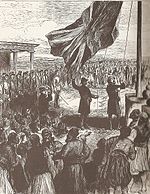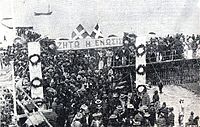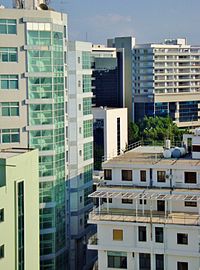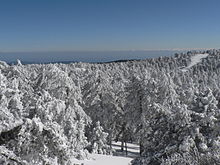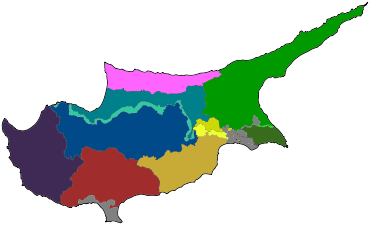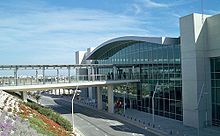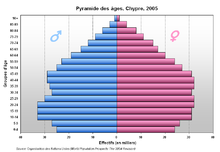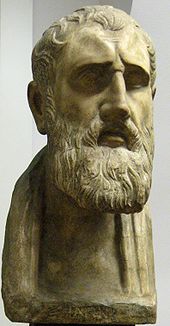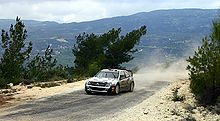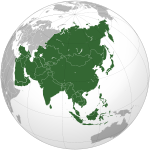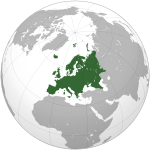- Cyprus
-
This article is about the island sovereign state. For other uses, see Cyprus (disambiguation).
Republic of Cyprus Κυπριακή Δημοκρατία (Greek)
Kypriakí Dimokratía
Kıbrıs Cumhuriyeti (Turkish)

Flag Coat of arms Anthem:
Ὕμνος εἰς τὴν Ἐλευθερίαν
Hymn to Liberty1Location of Cyprus (green)in the European Union (light green) — [Legend]
Capital
(and largest city)Nicosia (Λευκωσία, Lefkoşa)
35°08′N 33°28′E / 35.133°N 33.467°EOfficial language(s) Greek, Turkish[1] Ethnic groups (2001) 77% Greek
18% Turkish
5% others[2]Demonym Cypriot, Greek Cypriot, Turkish Cypriot Government Presidential republic - President Dimitris Christofias Independence from the United Kingdom - Zürich and London Agreement 19 February 1959 - Proclaimed 16 August 1960 Area - Total 9,251 km2 (167th)
3,572 (Includes North) sq mi- Water (%) negligible Population - 2010 estimate 803,147[3] (Does not include North)
1,088,503 (whole island)- Density 117/km2 (115th)
221/sq miGDP (PPP) 2010 estimate - Total $23.190 billion[4] - Per capita $28,256[4] GDP (nominal) 2010 estimate - Total $23.174 billion[4] - Per capita $28,237[4] Gini (2005) 29 (low) (19th) HDI (2011)  0.840 (very high) (31st)
0.840 (very high) (31st)Currency Euro2 ( EUR)Time zone EET (UTC+2) - Summer (DST) EEST (UTC+3) Drives on the Left ISO 3166 code CY Internet TLD .cy3 Calling code 357 1 Also the national anthem of Greece. 2 Before 2008, the Cypriot pound. 3 The .eu domain is also used, shared with other European Union member states. Cyprus
 i/ˈsaɪprəs/ (Greek: Κύπρος, Kýpros, IPA: [ˈcipros]; Turkish: Kıbrıs, IPA: [kɯbɾɯs]), officially the Republic of Cyprus (Greek: Κυπριακή Δημοκρατία, Kypriakī́ Dīmokratía, IPA: [cipriaˈci ðimokraˈtia]; Turkish: Kıbrıs Cumhuriyeti, IPA: [kɯbɾɯs dʒumhuɾijeti]), is a Eurasian island country, member of the European Union, in the Eastern Mediterranean,[5][6] east of Greece, south of Turkey, west of Syria and north of Egypt. It is the third largest island in the Mediterranean Sea.
i/ˈsaɪprəs/ (Greek: Κύπρος, Kýpros, IPA: [ˈcipros]; Turkish: Kıbrıs, IPA: [kɯbɾɯs]), officially the Republic of Cyprus (Greek: Κυπριακή Δημοκρατία, Kypriakī́ Dīmokratía, IPA: [cipriaˈci ðimokraˈtia]; Turkish: Kıbrıs Cumhuriyeti, IPA: [kɯbɾɯs dʒumhuɾijeti]), is a Eurasian island country, member of the European Union, in the Eastern Mediterranean,[5][6] east of Greece, south of Turkey, west of Syria and north of Egypt. It is the third largest island in the Mediterranean Sea.The earliest known human activity on the island dates back to around the 10th millennium BCE. Archaeological remains from this period include the well-preserved Neolithic village of Khirokitia, which has been declared a World Heritage Site by UNESCO, along with the Tombs of the Kings. Cyprus is home to some of the oldest water wells in the world,[7] and is the site of the earliest known example of feline domestication.[8][9] At a strategic location in the Middle East,[10][11][12][13] Cyprus has been occupied by several major powers, including the empires of the Hittites, Assyrians, Egyptians, Persians, Rashidun and Umayyad Arab caliphates, Lusignans, Venetians, and Ottomans. Settled by Mycenean Greeks in the 2nd millennium BCE, the island also experienced long periods of Greek rule under the Ptolemaic Egyptians and the Byzantines. In 333 BCE, Alexander the Great conquered the island from the Persians. The Ottoman Empire conquered the island in 1571 and it remained under Ottoman control for over three centuries. It was placed under British administration in 1878 until it was granted independence in 1960,[14] becoming a member of the Commonwealth the following year.
In 1974, following 11 years of intercommunal violence between Greek Cypriots and Turkish Cypriots,[15] an attempted coup d'état by Greek Cypriot nationalists[16][17] and elements of the Greek military junta[18] with the aim of achieving enosis (union of the island with Greece) took place.[18] Turkey used this as a pretext to invade the northern portion of the island. Turkish forces remained after a cease-fire, resulting in the partition of the island; an objective of Turkey since 1955.[18] The intercommunal violence and subsequent Turkish invasion led to the displacement of hundreds of thousands of Cypriots and the establishment of a separate Turkish Cypriot political entity in the north. These events and the resulting political situation are matters of ongoing dispute.
The Republic of Cyprus has de jure[19] sovereignty over the island of Cyprus and its surrounding waters, except for the British military bases of Akrotiri and Dhekelia. The Republic of Cyprus is de facto partitioned into two main parts; the area under the effective control of the Republic of Cyprus, comprising about 59% of the island's area, and the Turkish-controlled area in the north,[20] calling itself the Turkish Republic of Northern Cyprus and recognised only by Turkey, covering about 36% of the island's area.
Cyprus is the third most populous island in the Mediterranean Sea and one of its most popular tourist destinations.[21] An advanced,[22] high-income economy with a very high Human Development Index,[23][24] the Republic of Cyprus was a founding member of the Non-Aligned Movement until it joined the European Union on 1 May 2004.[25][26] On January 1 2008, Cyprus joined the Euro.
Contents
Etymology
The earliest attested reference to Cyprus is the Mycenaean Greek ku-pi-ri-jo, meaning "Cypriot", written in Linear B syllabic script.[27] The classical Greek form of the name is Κύπρος Kupros.
The etymology of the name is unknown. Suggestions include:
- the Greek word for the Mediterranean cypress tree (Cupressus sempervirens), κυπάρισσος (kypárissos)
- the Greek name of the henna plant (Lawsonia alba), κύπρος (kýpros)
- an Eteocypriot word for copper. Georges Dossin, for example, suggests that it has roots in the Sumerian word for copper (zubar) or for bronze (kubar), from the large deposits of copper ore found on the island.
Through overseas trade, the island has given its name to the Classical Latin word for copper through the phrase aes Cyprium, "metal of Cyprus", later shortened to Cuprum.[28] Cyprus, more specifically the shores of Paphos, was also one of the birthplaces of Aphrodite given in Greek mythology, who was known as Kupria, since according to Phoenician mythology, Astarte, goddess of love and beauty, was later identified with Aphrodite.
The standard demonym relating to Cyprus or its people or culture is Cypriot. The terms Cypriote and Cyprian are also, less frequently, used.
History
Main articles: History of Cyprus and Timeline of Cypriot historyAncient times
Main articles: Prehistoric Cyprus and Ancient history of CyprusThe earliest confirmed site of human activity on Cyprus is Aetokremnos, situated on the south coast, indicating that hunter-gatherers were active on the island from around 10,000 BCE,[29] with settled village communities dating from 8200 BC. The arrival of the first humans correlates with the extinction of the dwarf hippos and dwarf elephants.[30] Water wells discovered by archaeologists in western Cyprus are believed to be among the oldest in the world, dated at 9,000 to 10,500 years old.[7]
Remains of an 8-month-old cat were discovered buried with its human owner at a separate Neolithic site in Cyprus.[8] The grave is estimated to be 9,500 years old, predating ancient Egyptian civilization and pushing back the earliest known feline-human association significantly.[9] The remarkably well-preserved Neolithic village of Khirokitia is a UNESCO World Heritage Site dating to approximately 6800 BCE.[31]
The island was part of the Hittite empire during the late Bronze Age until the arrival of two waves of Greek settlement.[32] The first wave consisted of Mycenaean Greek traders who started visiting Cyprus around 1400 BCE.[33][34] A major wave of Greek settlement is believed to have taken place following the Bronze Age collapse of Mycenaean Greece in the period 1100–1050 BCE, with the island's predominantly Greek character dating from this period.[34][35] Cyprus occupies an important role in Greek mythology being the birthplace of Aphrodite and Adonis, and home to King Cinyras, Teucer and Pygmalion.[36] Beginning in the 8th century BCE Phoenician colonies were founded on the south coast of Cyprus, near present day Larnaca and Salamis.[34]
Cyprus was ruled by Assyria for a century starting in 708 BCE, before a brief spell under Egyptian rule and eventually Persian rule in 545 BCE.[34] The Cypriots, led by Onesilus, king of Salamis, joined their fellow Greeks in the Ionian cities during the unsuccessful Ionian Revolt in 499 BCE against the Achaemenid Empire. The revolt was suppressed, but Cyprus managed to maintain a high degree of autonomy and remained oriented towards the Greek world.[34]
The island was brought under permanent Greek rule by Alexander the Great and the Ptolemies of Egypt following his death. Full Hellenization took place during the Ptolemaic period, which ended when Cyprus was annexed by the Roman Republic in 58 BCE.[34]
Middle Ages
Main article: Cyprus in the Middle AgesWhen the Roman Empire was divided into Eastern and Western parts in 395, Cyprus became part of the East Roman, or Byzantine Empire, and would remain part of it until the Crusades some 800 years later. Under Byzantine rule, the Greek orientation that had been prominent since antiquity developed the strong Hellenistic-Christian character that continues to be a hallmark of the Greek Cypriot community.[34] Beginning in 649, Cyprus suffered from devastating raids launched from the Levant, which continued for the next 300 years.[34] Many were quick piratical raids, but others were large-scale attacks in which many Cypriots were slaughtered and great wealth carried off or destroyed.[34]
No Byzantine churches survive from this period, thousands of people were killed, and many cities – such as Salamis – were destroyed and never rebuilt.[34] Byzantine rule was restored in 965, when Emperor Nikephoros II Phokas scored decisive victories on land and sea.[34] In 1191, during the Third Crusade, Richard I of England captured the island from Isaac Komnenos of Cyprus[37] He used it as a major supply base that was relatively safe from the Saracens. A year later Richard sold the island to the Knights Templar, who, following a bloody revolt, in turn sold it to Guy of Lusignan. His brother and successor Amalric was recognized as King of Cyprus by Henry VI, Holy Roman Emperor.[34]
Following the death in 1473 of James II, the last Lusignan king, the Republic of Venice assumed control of the island, while the late king's Venetian widow, Queen Catherine Cornaro, reigned as figurehead. Venice formally annexed Cyprus in 1489, following the abdication of Caterina.[34] The Venetians fortified Nicosia by building the famous Venetian Walls, and used it as an important commercial hub. Throughout Venetian rule, the Ottoman Empire frequently raided Cyprus. In 1539 the Ottomans destroyed Limassol and so fearing the worst, the Venetians also fortified Famagusta and Kyrenia.[34]
During the almost four centuries of Latin rule, there existed two societies on Cyprus. The first consisted of Frankish nobles and their retinue, as well as Italian merchants and their families. The second, the majority of the population, consisted of Greek Cypriots, serfs and laborers. Although a determined effort was made to supplant native traditions and culture, the effort failed.[34]
Ottoman Empire
Main article: Ottoman Cyprus Historical map of Cyprus by Piri Reis
Historical map of Cyprus by Piri Reis
In 1570, a full scale Ottoman assault with 60,000 troops brought the island under Ottoman control, despite stiff resistance by the inhabitants of Nicosia and Famagusta. 20,000 Nicosians were put to death, and every church, public building, and palace was looted.[38] The previous Latin elite was destroyed and the first significant demographic change since antiquity took place when Ottoman Janissaries were settled on the island.[16]
The Ottomans abolished the feudal system previously in place and applied the millet system to Cyprus, under which non-Muslim peoples were governed by their own religious authorities. In a reversal from the days of Latin rule, the head of the Church of Cyprus was invested as leader of the Greek Cypriot population and acted as mediator between Christian Greek Cypriots and the Ottoman authorities.[38] Ottoman rule of Cyprus was at times indifferent, at times oppressive, depending on the temperaments of the sultans and local officials, and during this period the island fell into economic decline.[38]
In 1828, modern Greece’s first president Ioannis Kapodistrias whose maternal ancestors were Greek Cypriots,[39][40] called for union of Cyprus with Greece, and numerous minor uprisings took place.[41] Reaction to Ottoman misrule led to uprisings by both Greek and Turkish Cypriots, although none were successful. By 1872, the population of the island had risen to 144,000 comprising 44,000 Muslims and 100,000 Christians.[42] Centuries of neglect by the Turks, the unrelenting poverty of most of the people, and the ever-present tax collectors fuelled Greek nationalism, and by 19th century the idea of enosis, or union, with newly independent Greece was firmly rooted among Greek Cypriots.[38]
British Empire
Main article: Modern history of CyprusIn the aftermath of the Russo-Turkish War (1877–1878) and the Congress of Berlin, Cyprus was leased to the British Empire which de facto took over its administration in 1878 (though, in terms of sovereignty, it remained a de jure Ottoman territory until 1914, together with Egypt and Sudan) in exchange for guarantees that Britain would use the island as a base to protect the Ottoman Empire against possible Russian aggression.[34] The island would serve Britain as a key military base in its colonial routes. By 1906, when the Famagusta harbour was completed, Cyprus was a strategic naval outpost overlooking the Suez Canal, the crucial main route to India which was then Britain's most important colony. Following the outbreak of World War I and the entry of the Ottoman Empire on the side of the Central Powers, Great Britain formally annexed the island on 5 November 1914.[34]
In 1915, Britain offered Cyprus to Constantine I of Greece on condition that Greece join the war on the side of the British, which he declined. In 1923, under the Treaty of Lausanne, the nascent Turkish republic relinquished any claim to Cyprus and in 1925 it was declared a British crown colony.[34] Many Greek Cypriots fought in the British Army during both World Wars, in the hope that Cyprus would eventually be united with Greece.[43] During World War II many enlisted in the Cyprus Regiment.
In January 1959, the Church of Cyprus organized a referendum, which was boycotted by the Turkish Cypriot community, where over 90%[clarification needed] voted in favor of "enosis", meaning union with Greece.[44][45] Restricted autonomy under a constitution was proposed by the British administration but eventually rejected. In 1955 the EOKA organisation was founded, seeking independence and union with Greece through armed struggle. At the same time the Turkish Resistance Organisation (TMT), calling for Taksim, or partition, was established by the Turkish Cypriots as a counterweight.[46] Turmoil on the island was met with force by the British.
Independence
 The first president of Cyprus Makarios III
The first president of Cyprus Makarios III
On 16 August 1960, Cyprus attained independence after the Zürich and London Agreement between the United Kingdom, Greece and Turkey. The UK retained the two Sovereign Base Areas of Akrotiri and Dhekelia, while government posts and public offices were allocated by ethnic quotas, giving the minority Turkish Cypriots a permanent veto, 30% in parliament and administration, and granting the three mother-states guarantor rights.
In 1963, inter-communal violence broke out, partially sponsored by both "motherlands". As a result, Turkish Cypriots were forced into enclaves and Cypriot President Archbishop Makarios III called for unilateral constitutional changes as a means to ease tensions over the whole island. The United Nations forces deployed in Cyprus (UNFICYP) at flash points.[47]
In 1964, Turkey tried to intervene in Cyprus[48] in response to the ongoing Cypriot intercommunal violence. But Turkey was stopped by a strongly worded telegram from the US President Lyndon B. Johnson on 5 June, warning that the United States would not stand beside Turkey in case of a consequential Soviet invasion of Turkish territory.[49]
Contemporary era
Main articles: Greek military junta of 1967–1974, Cypriot intercommunal violence, and Turkish invasion of CyprusOn 15 July 1974, the Greek military junta carried out a coup d'état in Cyprus, to unite the island with Greece. The coup ousted president Makarios III and replaced him with pro-enosis nationalist Nikos Sampson.[50]. Five days later, on the 20th July 1974, the Turkish army invaded the island on the pretext of restoring the constitutional order of the Republic of Cyprus by claiming a right to intervene as one of the guarantors of the 1960 Treaty of Guarantee.
The Turkish air force began bombing Greek positions on Cyprus, hundreds of paratroops were dropped in the area between Nicosia and Kyrenia, where well-armed Turkish Cypriot enclaves had been long-established, while off the Kyrenia coast, 30 Turkish troop ships protected by destroyers landed 6,000 men as well as tanks, trucks, and armored vehicles.
Three days later, when a ceasefire had been agreed, Turkey had landed 30,000 troops on the island and captured Kyrenia, the corridor linking Kyrenia to Nicosia, and Turkish Cypriot quarter of Nicosia itself. The junta in Athens, and then the Sampson regime in Cyprus fell from power. In Nicosia, Glafkos Clerides assumed the presidency and constitutional order was restored, removing the pretext for the Turkish invasion. But during the negotiations, the Turks reinforced their Kyrenia bridgehead and prepared for a second invasion. The invasion began on 14 August and resulted in the seizure of Morphou, Karpass, Famagusta and the Mesaoria. The Greek-Cypriot forces were unable to resist the Turkish advance.
International pressure led to a ceasefire, and by then 37% of the island had been taken over by the Turks and 180,000 Greek Cypriots had been evicted from their homes in the north.[51] At the same time, around 50,000 Turkish Cypriots moved to the areas under the control of the Turkish Forces and settled in the properties of the displaced Greek Cypriots. Among a variety of sanctions against Turkey, in mid-1975 the US Congress imposed an arms embargo on Turkey for using American-supplied equipment during the Turkish invasion of Cyprus in 1974.[52]
After the restoration of constitutional order and the return of Archbishop Makarios III to Cyprus in December 1974, the Turkish troops remained on the island occupying the northeastern portion of the island. In 1983, Turkish Cypriots proclaimed the Turkish Republic of Northern Cyprus, which is recognised only by Turkey. As of today, there are 1,534 Greek Cypriots[53] and 502 Turkish Cypriots[54] missing as a result of the fighting. The events of the summer of 1974 dominate the politics on the island, as well as Greco-Turkish relations. Around 150,000 settlers from Turkey are believed to be living in the north in violation of the Geneva Convention and various UN resolutions.[55][56] Following the invasion and the capture of its northern territory by Turkish troops, the Republic of Cyprus announced that all of its ports of entry in the north were closed, as they were effectively not under its control.[citation needed]
The Turkish invasion and occupation and the self-declaration of independence of the TRNC have been condemned by several United Nations Resolutions. The Security Council reaffirms this every year.[57] The last major effort to settle the Cyprus dispute was the Annan Plan in 2004. It gained the support of the Turkish Cypriots but was rejected by the Greek Cypriots, who perceived it to disproportionately favor Turks.[58]
On May 1, 2004 Cyprus joined the European Union together with nine other countries.[59] In July 2006, the island served as a safe haven for people fleeing Lebanon because of the conflict between Israel and Hezbollah.[60]
In March 2008, a wall that for decades had stood at the boundary between the Republic of Cyprus and the UN buffer zone was demolished.[61] The wall had cut across Ledra Street in the heart of Nicosia and was seen as a strong symbol of the island's 32-year division. On 3 April 2008, Ledra Street was reopened in the presence of Greek and Turkish Cypriot officials.[62]
Geography
Main article: Geography of Cyprus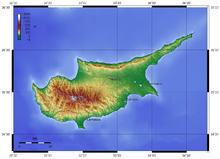 Topographic map of Cyprus. Troodos Mountains in the southwest, Mesaoria plain in the middle, Kyrenia Mountains in the north.
Topographic map of Cyprus. Troodos Mountains in the southwest, Mesaoria plain in the middle, Kyrenia Mountains in the north. The Troodos Mountains experience heavy snowfall in winter.
The Troodos Mountains experience heavy snowfall in winter.
Cyprus is the third largest island in the Mediterranean Sea, after the Italian islands of Sicily and Sardinia (both in terms of area and population). It is also the world's 81st largest by area and world's 49th largest by population. It measures 240 kilometres (149 mi) long from end to end and 100 kilometres (62 mi) wide at its widest point, with Turkey 75 kilometres (47 mi) to the north. It lies between latitudes 34° and 36° N, and longitudes 32° and 35° E.
Other neighbouring territories include Syria and Lebanon to the east (105 kilometres (65 mi) and 108 kilometres (67 mi), respectively), Israel 200 kilometres (124 mi) to the southeast, Egypt 380 kilometres (236 mi) to the south, and Greece to the northwest: 280 kilometres (174 mi) to the small Dodecanesian island of Kastelorizo (Megisti), 400 kilometres (249 mi) to Rhodes, and 800 kilometres (497 mi) to the Greek mainland.
The physical relief of the island is dominated by two mountain ranges, the Troodos Mountains and the smaller Kyrenia Range, and the central plain they encompass, the Mesaoria. The Mesaoria plain is drained by the Pedieos River, the longest on the island. The Troodos Mountains cover most of the southern and western portions of the island and account for roughly half its area. The highest point on Cyprus is Mount Olympus at 1,952 m (6,404 ft), located in the centre of the Troodos range. The narrow Kyrenia Range, extending along the northern coastline, occupies substantially less area, and elevations are lower, reaching a maximum of 1,024 m (3,360 ft).
Geopolitically, the island is subdivided into four main segments. The Republic of Cyprus occupies the southern two-thirds of the island (59.74%). The Turkish Republic of Northern Cyprus occupies the northern third (34.85%), and the United Nations-controlled Green Line provides a buffer zone that separates the two and covers 2.67% of the island. Lastly, two bases under British sovereignty are located on the island: Akrotiri and Dhekelia, covering the remaining 2.74%.
Climate
Main article: Climate of Cyprus Petra tou Romiou ("Rock of the Greek"), where according to mythology the goddess Aphrodite emerged from the sea.
Petra tou Romiou ("Rock of the Greek"), where according to mythology the goddess Aphrodite emerged from the sea.
Cyprus has a subtropical climate – Mediterranean and Semi-arid type (in the north-eastern part of island) – according to Köppen climate classification signes Csa and Bsh,[63][64] with very mild winters (on the coast) and warm to hot summers. Snow is possible only in the Troodos Mountains in the central part of island. Rain occurs mainly in winter, with summer being generally dry.
Cyprus has the warmest climate (and warmest winters) in the Mediterranean part of the European Union. The average annual temperature on the coast is around 24 °C (75 °F) during the day and 14 °C (57 °F) at night. Generally – summer's/holiday season lasts about 8 months, begins in April with average temperatures of 21–23 °C (70–73 °F) during the day and 11–13 °C (52–55 °F) at night, ends in November with average temperatures of 22–23 °C (72–73 °F) during the day and 12–14 °C (54–57 °F) at night, although also in remaining 4 months temperatures sometimes exceeds 20 °C (68 °F). Among all cities in the Mediterranean part of the European Union, Limassol has the warmest winters, in the period January–February average temperature is 17–18 °C (63–64 °F) during the day and 8–9 °C (46–48 °F) at night, in other coastal locations in Cyprus is generally 16–17 °C (61–63 °F) during the day and 7–9 °C (45–48 °F) at night. In March and December in Limassol average temperatures is 19–20 °C (66–68 °F) during the day and 10–11 °C (50–52 °F) at night, in other coastal locations in Cyprus is generally 17–19 °C (63–66 °F) during the day and 8–11 °C (46–52 °F) at night. Middle of summer is hot – in July and August on the coast the average temperature is usually around 33 °C (91 °F) during the day and around 23 °C (73 °F) at night (inside the island, in the highlands average temperature exceeds 35 °C (95 °F)) while in the June and September on the coast the average temperature is usually around 30 °C (86 °F) during the day and around 20 °C (68 °F) at night. Large fluctuations in temperature are rare. Temperatures inside the island are more stringent, with colder winters and more hot summers compared with the coast of the island.[65]
Average annual temperature of sea is 21–22 °C (70–72 °F), from 17 °C (63 °F) in February to 27–28 °C (81–82 °F) in August (depending on the location). In total 7 months – from May to November – the average sea temperature exceeds 20 °C (68 °F).[66]
Sunshine hours on the coast is around 3,400 per year, from average 5–6 hours of sunshine / day in December to average 12–13 hours in July.[66] This is about double that of cities in the northern half of Europe, for comparison: London – 1,461,[67] however in winter up to some times more sunshine, for comparison: London has 37 hours[67] while coastal locations in Cyprus has around 180 hours of sunshine in December (that is, as much as in May in London).
Water supply
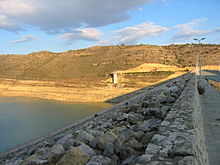 Kouris Dam is the largest of a network of 107 dams in Cyprus.
Kouris Dam is the largest of a network of 107 dams in Cyprus.
Cyprus is suffering from an ongoing shortage of water. The country relies heavily on rain to provide household water and for many years now, the average annual rainfall seemed to be falling. Between 2001 and 2004, exceptionally heavy annual rainfall pushed water reserves up, with supply exceeding demand, allowing total storage in the island's reservoirs to rise to an all time high by the start of 2005. However, since then demand has increased annually – a result of local population growth, foreigners relocating to Cyprus and the number of visiting tourists – while supply has fallen. Cyprus has a total of 107 dams (plus one currently under construction) and reservoirs, with a total water storage capacity of about 330,000,000 m3 (1.2×1010 cu ft).[68] Dams remain the principal source of water both for domestic and agricultural use. Water desalination plants are gradually being constructed in order to deal with recent years of prolonged drought. The Government has invested heavily in the creation of water desalination plants which have supplied almost 50 percent of domestic water since 2001. Efforts have also been made to raise public awareness of the situation and to encourage domestic water users to take more responsibility for the conservation of this increasingly scarce commodity.
Politics
Main article: Politics of Cyprus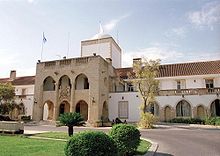 The Presidential Palace (Residence) in Nicosia.
The Presidential Palace (Residence) in Nicosia.
Cyprus is a Presidential republic. The head of state and of the government is elected by a process of Universal suffrage for a five-year term. Executive power is exercised by the government with legislative power vested in the House of Representatives whilst the Judiciary is independent of both the executive and the legislature. The 1960 Constitution provided for a presidential system of government with independent executive, legislative and judicial branches as well as a complex system of checks and balances including a weighted power-sharing ratio designed to protect the interests of the Turkish Cypriots. The executive was led by a Greek Cypriot president and a Turkish Cypriot vice president elected by their respective communities for five-year terms and each possessing a right of veto over certain types of legislation and executive decisions. Legislative power rested on the House of Representatives who were also elected on the basis of separate voters' rolls.
Following clashes between the two communities the Turkish Cypriot seats in the House remain vacant since 1965. Turkish Cypriots refused to establish the state of affairs before the invasion of Cyprus as is evident in the Secretary-General of the United Nations who said "The Turkish Cypriot leaders have adhered to a rigid stand against any measures which might involve having members of the two communities live and work together, or which might place Turkish Cypriots in situations where they would have to acknowledge the authority of Government agents. Indeed, since the Turkish Cypriot leadership is committed to physical and geographical separation of the communities as a political goal, it is not likely to encourage activities by Turkish Cypriots which may be interpreted as demonstrating the merits of an alternative policy. The result has been a seemingly deliberate policy of self-segregation by the Turkish Cypriots."[69] By 1974 the two communities had returned to a more tolerant state of living.[69]
 Cyprus president Dimitris Christofias and Cyprus first lady with U.S. President Barack Obama and Michelle Obama.
Cyprus president Dimitris Christofias and Cyprus first lady with U.S. President Barack Obama and Michelle Obama.
In 1974 Cyprus was divided de facto when the Turkish army occupied the northern third of the island. The Turkish Cypriots subsequently declared independence in 1983 as the Turkish Republic of Northern Cyprus but were recognized only by Turkey. In 1985 the TRNC adopted a constitution and held its first elections. The United Nations recognises the sovereignty of the Republic of Cyprus over the entire island of Cyprus.
The House of Representatives currently has 59 members elected for a five year term, 56 members by proportional representation and 3 observer members representing the Armenian, Latin and Maronite minorities. 24 seats are allocated to the Turkish community but remain vacant since 1964. The political environment is dominated by the communist AKEL, the liberal conservative Democratic Rally, the centrist[70] Democratic Party, the social-democratic EDEK and the centrist EURO.KO. On 17 February 2008 Dimitris Christofias of the AKEL was elected President of Cyprus, on AKEL's first electoral victory without being part of a wider coalition. Christofias took over government from Tassos Papadopoulos of the Democratic Party who had been in office since February 2003.
Administrative divisions
Main articles: Districts of Cyprus and List of cities, towns and villages in CyprusThe Republic of Cyprus is divided into six districts:[71] Nicosia, Famagusta, Kyrenia, Larnaca, Limassol and Paphos. These are not the same as those of Northern Cyprus.
District Map of Cyprus Districts Greek name Turkish name Famagusta Αμμόχωστος (Ammochostos) Gazimağusa/Mağusa Kyrenia Κερύvεια (Keryneia) Girne Larnaca Λάρνακα (Larnaka) Larnaka/İskele Limassol Λεμεσός (Lemesos) Limasol/Leymosun Nicosia Λευκωσία (Lefkosia) Lefkoşa Paphos Πάφος (Pafos) Baf/Gazibaf Exclaves and enclaves
 Episkopi Cantonment in south-southwest Cyprus.
Episkopi Cantonment in south-southwest Cyprus.
Cyprus has four exclaves, all in territory that belongs to the British Sovereign Base Area of Dhekelia. The first two are the villages of Ormidhia and Xylotymvou. The third is the Dhekelia Power Station which is divided by a British road into two parts. The northern part is an exclave, like the two villages, whereas the southern part is located by the sea and therefore not an exclave although it has no territorial waters of its own.[72]
The UN buffer zone runs up against Dhekelia and picks up again from its east side off Ayios Nikolaos and is connected to the rest of Dhekelia by a thin land corridor. In that sense the buffer zone turns the Paralimni area on the southeast corner of the island into a de facto, though not de jure, exclave.
Foreign relations
Main article: Foreign relations of CyprusThe island nation Cyprus is member of: Australia Group, CN, CE, CFSP, EBRD, EIB, EU, FAO, IAEA, IBRD, ICAO, ICC, ICCt, ITUC, IDA, IFAD, IFC, IHO, ILO, IMF, IMO, Interpol, IOC, IOM, IPU, ITU, MIGA, NAM, NSG, OPCW, OSCE, PCA, UN, UNCTAD, UNESCO, UNHCR, UNIDO, UPU, WCL, WCO, WFTU, WHO, WIPO, WMO, WToO, WTO.[73][74]
Human rights
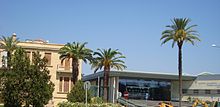 Cyprus Court of Justice in Nicosia, Cyprus
Cyprus Court of Justice in Nicosia, Cyprus Main article: Human rights in Cyprus
Main article: Human rights in CyprusIn "Freedom in the World 2011", Freedom House rated the democracy of Cyprus as "free".[75] The constant focus on the division of the island can sometimes mask other human rights issues. Prostitution is rife in both the Republic of Cyprus and the Turkish-controlled regions leading to the government being criticised for its lack of controls[76] and for the role of Cyprus in the sex trade as one of the main destinations for human trafficking from Eastern Europe.[77]
There have been reports of mistreatment to the Turkish Cypriots in the Republic of Cyprus.[78][79] The US Department of State report about human rights in Cyprus in 2002 said that:[80]
Some of the approximately 300 Turkish Cypriots living in the government-controlled area faced difficulties in obtaining identification cards and other government documents, especially if they were born after 1974. Turkish Cypriots also appeared to be subjected to surveillance by the Greek Cypriot police.Domestic violence legislation remains largely unimplemented[81] and mistreatment of domestic staff, mostly immigrant workers from developing countries, are sometimes reported in the Cypriot press[78] and are the subject of several campaigns by the anti-racist charity KISA.
Military
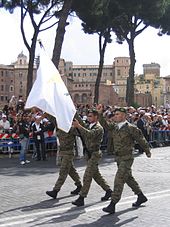 Soldiers of Cypriot National Guard marching in Rome.
Soldiers of Cypriot National Guard marching in Rome. Main article: Cypriot National Guard
Main article: Cypriot National GuardThe Cypriot National Guard is the main military institution of the Republic of Cyprus. It is a combined arms force, with land, air and naval elements. The National Guard is a required 24 month service for all men upon completing their 18th birthday. The land forces of the Cypriot National Guard comprise the following units:
- First Infantry Division (Ιη Μεραρχία ΠΖ)
- Second Infantry Division (ΙΙα Μεραρχία ΠΖ)
- Fourth Infantry Brigade (ΙVη Ταξιαρχία ΠΖ)
- Twentieth Armored Brigade (ΧΧη ΤΘ Ταξιαρχία)
- Third Support Brigade (ΙΙΙη Ταξιαρχία ΥΠ)
- Eighth Support Brigade (VIIIη Ταξιαρχία ΥΠ)
The air force includes the 449th Helicopter Gunship Squadron (449 ΜΑΕ) – operating SA-342L and Bell 206 and the 450th Helicopter Gunship Squadron (450 ME/P) – operating Mi-35P, BN-2B and PC-9. Current Senior officers include Supreme Commander, Cypriot National Guard, Lt. General Stylianos Nasis,[82] and Chief of Staff, Cypriot National Guard: Maj. General Mihalis Flerianos.[citation needed]
Economy
Main article: Economy of Cyprus The city of Limassol is a major port and touristic hub in the Mediterranean.
The city of Limassol is a major port and touristic hub in the Mediterranean.
The Cypriot economy is prosperous and has diversified in recent years.[83] According to the latest International Monetary Fund estimates, its per capita GDP (adjusted for purchasing power) at $28,381 is just above the average of the European Union.[84] Cyprus has been sought as a base for several offshore businesses for its highly developed infrastructure. Tourism, financial services, and shipping are significant parts of the economy. Economic policy of the Cyprus government has focused on meeting the criteria for admission to the European Union. The Cypriot government adopted the euro as the national currency on 1 January 2008.[83]
 Cyprus has been part of the Eurozone since 2008.
Cyprus has been part of the Eurozone since 2008.
In recent years significant quantities of offshore natural gas have been discovered in the area known as Aphrodite in Cyprus' exclusive economic zone (EEZ),[85] about 175 km south of Limassol at 33°5′40″N and 32°59′0″E.[86] Cyprus demarcated its maritime border with Egypt in 2003, and with Lebanon in 2007.[87] Cyprus and Israel demarcated their maritime border in 2010,[88] and in August 2011, the US-based firm Noble Energy entered into a production-sharing agreement with the Cypriot government regarding the block's commercial development.[89] Turkey, which does not recognize the border agreements of Cyprus with its neighbors,[90] threatened to mobilize its naval forces in the event that Cyprus would proceed with plans to begin drilling at Block 12.[91] Cyprus' drilling efforts have the support of the US, EU, and UN, and on September 19 2011 drilling in Block 12 began without any incidents being reported.[92]
The economy of the Turkish-occupied areas operates on a free-market basis although it continues to be handicapped by the lack of private and public investment, high freight costs and shortages of skilled labor. Despite these constraints the economy turned in an impressive performance in 2003 and 2004 with growth rates of 9.6% and 11.4%. The average income in the area was $15,984 (S₣16,289) in 2008.[93] Growth has been buoyed by the relative stability of the Turkish new lira and by a boom in the education and construction sectors. The island has witnessed a massive growth in tourism over the years and as such the property rental market in Cyprus has grown alongside. Added to this is the capital growth in property that has been created from the demand of incoming investors and property buyers to the island.[94]
Transport
 Port of Limassol, the busiest in Cyprus.
Port of Limassol, the busiest in Cyprus. Main article: Transport in CyprusMain article: Motorways and roads in Cyprus
Main article: Transport in CyprusMain article: Motorways and roads in CyprusAvailable modes of transport are by road, sea, and air. Of the 10,663 km (6,626 mi) of roads in the Republic of Cyprus as of 1998, 6,249 km (3,883 mi) were paved, and 4,414 km (2,743 mi) were unpaved. As of 1996 the Turkish occupied area had a similar ratio of paved to unpaved, with approximately 1,370 km (850 mi) of paved road and 980 km (610 mi) unpaved. Cyprus is one of only four EU nations in which vehicles drive on the left-hand side of the road, a remnant of British colonisation, the others being Ireland, Malta and the United Kingdom.
There are several modern motorways in Cyprus. A series of motorways runs along the coast from Paphos east to Ayia Napa, with two motorways running inland to Nicosia, one from Limassol and one from Larnaca.
- A1 Nicosia to Limassol
- A2 connects A1 near Pera Chorio with A3 by Larnaca
- A3 Larnaca to Agia Napa
- A5 connects A1 near Kofinou with A3 by Larnaca
- A6 Pafos to Limassol
- A9 Nicosia to Astromeritis
Per capita private car ownership is the 5th highest in the world. There are approximately 344,000 privately owned vehicles, and a total of 517,000 registered motor vehicles in the Republic of Cyprus.[95] In 2006 extensive plans were announced to improve and expand bus services and restructure public transport throughout Cyprus, with the financial backing of the European Union Development Bank. In 2010 the new revised and expanded bus network was implemented.[96]
In 1999, Cyprus had six heliports and two international airports: Larnaca International Airport and Paphos International Airport. Nicosia International Airport has been closed since 1974 and although Ercan airport was still in use it was only for flights from Turkey.
The main harbours of the island are Limassol and Larnaca, which service cargo, passenger, and cruise ships.
Communications
Main article: Communications in CyprusCyta, the state-owned telecommunications company, manages most Telecommunications and Internet connections on the island. However, following the recent liberalisation of the sector, a few private telecommunications companies have emerged including MTN, Cablenet, OTEnet Telecom, Omega Telecom and PrimeTel. In the Turkish-controlled area of Cyprus, three companies are also present. These are Turkcell, Vodafone and Turk Telekom.
Demographics
Main article: Demographics of CyprusIt has traditionally been accepted that Greek Cypriots form up to 80%, Turkish Cypriots 18% (not including Turkish settlers), and Christian minorities (including Maronites, Latin Catholic and Armenians) 2% of the Cypriot population.[97][98][99][100]
According to the first population census after the declaration of independence, carried out in December 1960 and covering the entire island, Cyprus had a total population of 573,566; of whom 442,138 (77.1%) were Greeks, 104,320 (18.2%) Turkish, and 27,108 (4.7%) others.[101][102]
Due to the inter-communal ethnic tensions between 1963 and 1974, an island-wide census was regarded as impossible. Nevertheless, the Greek Cypriots conducted one in 1973, without the Turkish Cypriot populace.[103] According to this census, the Greek Cypriot population was 482,000. One year later, in 1974, the Cypriot government's Department of Statistics and Research estimated the total population of Cyprus at 641,000; of whom 506,000 (78.9%) were Greeks, and 118,000 (18.4%) Turkish.[104] After the partition of the island in 1974, Greeks conducted four more censuses: in 1976, 1982, 1992 and 2001; these excluded the Turkish population which was resident in the northern part of the island.[101]
According to the Republic of Cyprus's latest estimate, in 2005, the number of Cypriot citizens currently living in the Republic of Cyprus is around 871,036 In addition to this the Republic of Cyprus is home to 110,200 foreign permanent residents[105] and an estimated 10,000–30,000 undocumented illegal immigrants currently living in the south of the island.[106]
According to the 2006 census carried out by Northern Cyprus, there were 256,644 (de jure) people living in Northern Cyprus. 178,031 were citizens of Northern Cyprus, of whom 147,405 were born in Cyprus (112,534 from the north; 32,538 from the south; 371 did not indicate what part of Cyprus they were from); 27,333 born in Turkey; 2,482 born in the UK and 913 born in Bulgaria. Of the 147,405 citizens born in Cyprus, 120,031 say both parents were born in Cyprus; 16,824 say both parents born in Turkey; 10,361 have one parent born in Turkey and one parent born in Cyprus.[107]
In 2010, the International Crisis Group estimated that the total population of Cyprus was 1.1 million,[108] of which there was an estimated 300,000 residents in the north, perhaps half of whom were either born in Turkey or are children of such settlers.[109] One source claims that the population in the north has reached 500,000,[110] 50% of which are thought to be Turkish settlers or Cypriot-born children of such settlers.[111]
The village of Pyla in the Larnaca District is the only settlement in the Republic of Cyprus with a mixed Greek and Turkish Cypriot population.
Y-Dna haplogroups are found at the following frequencies in Cyprus : J (43.07% including 6.20% J1), E1b1b (20.00%), R1 (12.30% including 9.2% R1b), F (9.20%), I (7.70%), K (4.60%), A (3.10%).[112] J, K, F and E1b1b haplogroups consist of lineages with differential distribution within Middle East, North Africa and Europe while R1 and I are typical in West European populations.
Outside Cyprus there is a significant and thriving Greek Cypriot diaspora and Turkish Cypriot diaspora in the United Kingdom, Australia, Canada, the United States, Greece and Turkey.
Religion
Main article: Religion in CyprusAlmost all Greek Cypriots are members of the autocephalous Greek Orthodox Church of Cyprus,[2][113][114] whereas most Turkish Cypriots are adherents of Sunni Islam. According to Eurobarometer 2005,[115] Cyprus is one of the most religious countries in the European Union, alongside Malta, Romania, Greece, and Poland. The first President of Cyprus, Makarios III, was an archbishop.

 Lefkara's orthodox church in Troodos Mountains (left) and Hala Sultan Tekke near Larnaca Salt Lake (right).
Lefkara's orthodox church in Troodos Mountains (left) and Hala Sultan Tekke near Larnaca Salt Lake (right).Given the special legal status of the Church of Cyprus, the country is also one of only six EU states to have an established state church, alongside Finland (Finnish Evangelical Lutheran Church and Finnish Orthodox Church), Denmark (Danish National Church), Greece (Church of Greece), Malta (Roman Catholic Church) and the United Kingdom (Church of England (only in England)). In addition to the Greek Orthodox and Muslim communities, there are also small Hindu, Sikh, Bahá'í, Jewish, Protestant (including Pentecostal), Catholic (including Latin Rite and Maronite) and Armenian Apostolic communities in Cyprus.
Hala Sultan Tekke, situated near the Larnaca Salt Lake, is considered by some secular orientalists as the third holiest site in Sunni Islam[116][117][118][119][120][121][122] and an object of pilgrimage for both Muslims and Christians.[123][124]
The current leader of the Greek Orthodox Church of Cyprus is Archbishop Chrysostomos II. He is known for his right-wing nationalist views, branding for example, illegal immigrants as "‘interlopers’ who do not belong on the island" and admits espousing several other political ideas of Cyprus' National People’s Front (ELAM).[125][126]
According to the 2001 census carried out in the Government controlled area,[127] 94.8% of the population are Christian Orthodox, 0.9% Armenians and Maronites, 1.5% Roman Catholics, 1.0% Church of England, and 0.6% Muslims. The remaining 1.3% adhere to other religious denominations or did not state their religion.
Languages
The country has two official languages: Greek and Turkish.[1] Armenian, Cypriot Maronite Arabic and Romani are also recognized as minority languages.[128] In addition to these languages – according the Eurobarometer by European Commission – 76% of the population of Cyprus speak English, 12% speak French, and 5% speak German.[129]
Education
For a complete list, see List of universities and colleges in Cyprus. Faneromeni School is the oldest all-girl primary school in Cyprus.
Faneromeni School is the oldest all-girl primary school in Cyprus.
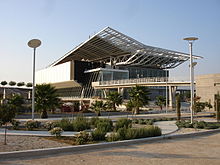 University of Cyprus modern facilities.
University of Cyprus modern facilities.
Cyprus has a highly developed system of primary and secondary education offering both public and private education. The high quality of instruction can be attributed to a large extent to the above-average competence of the teachers[citation needed] but also to the fact that nearly 7% of the GDP is spent on education which makes Cyprus one of the top three spenders of education in the EU along with Denmark and Sweden.[130]
State schools are generally seen as equivalent in quality of education to private-sector institutions. However, the value of a state high-school diploma is limited by the fact that the grades obtained account for only around 25% of the final grade for each topic, with the remaining 75% assigned by the teacher during the semester, in a minimally transparent way. Cypriot universities (like universities in Greece) ignore high school grades almost entirely for admissions purposes. While a high-school diploma is mandatory for university attendance, admissions are decided almost exclusively on the basis of scores at centrally administered university entrance examinations that all university candidates are required to take.
The majority of Cypriots receive their higher education at Greek, British, Turkish, other European and North American universities. It is noteworthy that Cyprus currently has the highest percentage of citizens of working age who have higher-level education in the EU at 30% which is ahead of Finland's 29.5%. In addition 47% of its population aged 25–34 have tertiary education, which is the highest in the EU. The body of Cypriot students is highly mobile, with 78.7% studying in a university outside Cyprus.
Culture
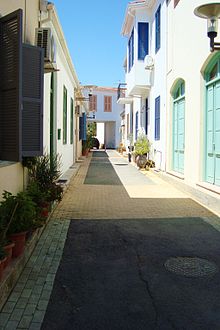 Typical Cypriot architecture in old part of Nicosia, Cyprus
Typical Cypriot architecture in old part of Nicosia, Cyprus
The culture of Cyprus is divided between the two distinct cultures of Greek and Turkish Cypriots. Each community maintains its own culture, linked to the cultures of Greece and Turkey, and there is little cultural interchange between the two groups. The Greek culture first has been present on the island since antiquity.[34] The Turkish culture arrived with the invasion of the Ottoman Empire in 1570, and it was under this rule that the divide between the two communities became prominent and encouraged by government policies. The British did nothing to change this, leaving the island in its divided state with no unified culture.[131]
Art
 Aphrodite; Greek goddess of love, beauty and sexuality is said to be born in Cyprus.
Aphrodite; Greek goddess of love, beauty and sexuality is said to be born in Cyprus.
The art history of Cyprus can be said to stretch back up to 10,000 years, following the discovery of a series of Chalcolithic period carved figures in the villages of Khoirokoitia and Lempa[132] and the island is also the home to numerous examples of high quality religious icon painting from the Middle Ages. Cypriot architecture was heavily influenced by French Gothic and Italian renaissance introduced in the island during the era of Latin domination (1191–1571).
In modern times Cypriot art history begins with the painter Vassilis Vryonides (1883–1958) who studied at the Academy of Fine Arts in Venice.[133] Arguably the two founding fathers of modern Cypriot art were Adamantios Diamantis (1900–1994) who studied at London's Royal College of Art and Christopheros Savva (1924–1968) who also studied in London, at St Martins School of Art.[134] In many ways these two artists set the template for subsequent Cypriot art and both their artistic styles and the patterns of their education remain influential to this day. In particular the majority of Cypriot artists still train in England[135] although art schools in Greece are also popular and local art institutions such as the Cyprus College of Art, University of Nicosia and the Frederick Institute of Technology are becoming more popular.
One of the features of Cypriot art is a tendency towards figurative painting although conceptual art is being rigorously promoted by a number of art “institutions” and most notably the Nicosia Municipal Art Centre [16]. Municipal art galleries exist in all the main towns and there is a large and lively commercial art scene. Cyprus was due to host the international art festival Manifesta in 2006 but this was cancelled at the last minute following a dispute between the Dutch organizers of Manifesta and the Cyprus Ministry of Education and Culture over the location of some of the Manifesta events in the Turkish sector of the capital Nicosia.[136][137]
Other notable Cypriot artists include Rhea Bailey, Mihail Kkasialos, Ioannis Kissonergis, Theodoulos Gregoriou, Helene Black, George Skoteinos, Kalopedis family, Nicos Nicolaides, Stass Paraskos, Arestís Stasí, Telemachos Kanthos, Konstantia Sofokleous and Chris Achilleos.
Music
 Bouzouki, the mainstay of most Cypriot folk music.
Bouzouki, the mainstay of most Cypriot folk music. Main article: Music of Cyprus
Main article: Music of CyprusThe traditional folk music of Cyprus has several common elements with Greek, Turkish, and Arabic music including Greco-Turkish dances such as the sousta, syrtos, zeibekikos, tatsia, and kartsilamas as well as the Middle Eastern-inspired tsifteteli and arapie. There is also a form of musical poetry known as chattista which is often performed at traditional feasts and celebrations. The instruments commonly associated with Cyprus folk music are the bouzouki (pictured), oud ("outi"), violin ("fkiolin"), lute ("laouto"), accordion, Cyprus flute ("pithkiavlin") and percussion (including the "toumperleki"). Composers associated with traditional Cypriot music include Evagoras Karageorgis, Marios Tokas, Solon Michaelides and Savvas Salides.
Popular music in Cyprus is generally influenced by the Greek Laïka scene with several artists including Anna Vissi, Evridiki, and Sarbel earning widespread popularity in Cyprus, Greece and parts of the Middle East. Hip Hop, R&B and reggae are also very popular genres on the island and have been supported by the emergence of Cypriot rap and the urban music scene at Ayia Napa. Cypriot rock music and Éntekhno rock is often associated with artists such as Michalis Hatzigiannis and Alkinoos Ioannidis. Metal also has a small following in Cyprus represented by bands such as Armageddon(rev.16:16), Blynd, Winter's Verge and Quadraphonic.
Literature
Main article: Cypriot literatureLiterary production of the antiquity includes the Cypria, an epic poem, probably composed in the late seventh century BCE and attributed to Stasinus. The Cypria is one of the very first specimens of Greek and European poetry.[139] The Cypriot Zeno of Citium was the founder of the Stoic School of Philosophy.
Epic poetry, notably the "acritic songs", flourished during Middle Ages. Two chronicles, one written by Leontios Machairas and the other by Georgios Voustronios, cover the entire Middle Ages until the end of Frankish rule (4th century – 1489). Poèmes d'amour written in medieval Greek Cypriot date back from 16th century. Some of them are actual translations of poems written by Petrarch, Bembo, Ariosto and G. Sannazzaro.[140] Many Cypriot scholars fled Cyprus at troubled times such as Ioannis Kigalas ( ca. 1622–1687) who migrated from Cyprus to Italy in the 17th century, several of his works have survived in books of other scholars.[141]
Hasan Hilmi Efendi, a Turkish Cypriot poet, was rewarded by the Ottoman sultan Mahmud II and said to be the "sultan of the poems".[142]
Modern literary figures from Cyprus include the poet and writer Kostas Montis, poet Kyriakos Charalambides, poet Michalis Pasiardis, writer Nicos Nicolaides, Stylianos Atteshlis, Altheides, Loukis Akritas[143] and Demetris Th. Gotsis. Dimitris Lipertis, Vasilis Michaelides and Pavlos Liasides are folk poets who wrote poems mainly in the Cypriot-Greek dialect.[144][145] Lawrence Durrell lived in Northern Cyprus from 1952 until 26 August 1956 and wrote the book Bitter Lemons concerning his time there which won the second Duff Cooper Prize in 1957. The majority of the play Othello by William Shakespeare is set on the island of Cyprus. Cyprus also figures in religious literature such as the Acts of the Apostles according to which the Apostles Barnabas and Paul preached on the island.
Cinema
The Cypriot cinema was born much later than the cinema of other countries and in the last decades the first coordinated steps have been taken to create a distinct Cypriot cinematography. The main reason for this delay was the belated entry of Cyprus into international society as an independent state in 1960, and the dramatic events that followed which left the island divided in a Greek and Turkish zones that remain divided.
During the late 60s and early 70s production showed a richer crop of films. George Filis produced and directed Gregoris Afxentiou, Etsi Prodothike i Kypros (Cyprus Betrayal), and the Mega Document.
Cinematographic production in Cyprus received a boost in 1994 with the establishment of the Cinema Advisory Committee. The annual amount currently set aside (2000) in the national budget stands at Cy Pounds 500,000 (about 850,000 Euros). In addition to government grants Cypriot co-productions are eligible for funding from the Eurimages Fund, a Council of Europe institution financing European film co-productions. To date four feature-length films in which a Cypriot was executive producer have received funding from Eurimages. The first was I Sphagi tou Kokora (1992) which has been completed in 1996, Hellados (And the trains fly to the sky, 1995), which is currently in the post-production phase and O Dromos gia tin Ithaki (The Road to Ithaka, 1997) of Costas Demetriou which was premiered in March 2000. In September 1999, To Tama (The Promise) of Andreas Pantzis has also received funding from the Eurimages Fund.[146]
Cuisine
Orange (fruit) in a tree in Omodos. The Mediterranean climate of Cyprus is suitable for orange production. Main article: Cypriot cuisine
Main article: Cypriot cuisineHalloumi cheese originated in Cyprus[147][148] and was initially made during the Medieval Byzantine period,[149] subsequently gaining popularity throughout the Middle-East. Halloumi (Hellim) is commonly served sliced, either fresh or grilled, as an appetiser.
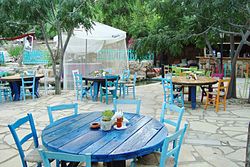 Modern Cypriot style tavern in Sirena Bay, Paralimni
Modern Cypriot style tavern in Sirena Bay, Paralimni
Seafood and fish dishes of Cyprus include squid, octopus, red mullet, and sea bass. Cucumber and tomato are used widely in salads. Common vegetable preparations include potatoes in olive oil and parsley, pickled cauliflower and beets, asparagus and Taro. Other traditional delicacies of the island are meat marinated in dried coriander, seeds and wine, and eventually dried and smoked, such as lountza (smoked pork loin), charcoal-grilled lamb, souvlaki (pork and chicken cooked over charcoal), and sheftalia (minced meat wrapped in mesentery). Pourgouri (bulgur, cracked wheat) is the traditional carbohydrate other than bread, and is used to make the Cypriot delicacy koubes.
Fresh vegetables and fruits are common ingredients in Cypriot cuisine. Frequently used vegetables include courgettes, green peppers, okra, green beans, artichokes, carrots, tomatoes, cucumbers, lettuce and grape leaves, and pulses such as beans, broad beans, peas, black-eyed beans, chick-peas and lentils. The commonest among fruits and nuts are pears, apples, grapes, oranges, mandarines, nectarines, mespila, blackberries, cherry, strawberries, figs, watermelon, melon, avocado, lemon, pistachio, almond, chestnut, walnut, hazelnut.
Cyprus is also well known for its desserts, including lokum (also known as Turkish Delight) and Soutzoukos.[150] This island has protected geographical indication (PGI) for its lokum produced in the village of Geroskipou.[151]
Sports
 Marcos Baghdatis, Cypriot professional tennis player
Marcos Baghdatis, Cypriot professional tennis player
Governing bodies of sports in Cyprus include the Cyprus Football Association, Cyprus Basketball Federation, Cyprus Volleyball Federation, Cyprus Automobile Association, Cyprus Badminton Federation,[152] Cyprus Cricket Association and the Cyprus Rugby Federation.
Football is by far the most popular spectator sport. The Cyprus League is nowadays considered as quite competitive and includes notable teams such as AC Omonia, APOEL FC, AEL Lemesos, Apollon FC, Anorthosis Famagusta FC, Nea Salamis Famagusta FC and AEK Larnaca FC. Stadiums or sports venues in Cyprus include the GSP Stadium (the largest in Cyprus), Tsirion Stadium (second largest), Neo GSZ Stadium, Antonis Papadopoulos Stadium, Ammochostos Stadium and Makario Stadium. Cyprus, also has a football national team which in the last decade has evolved to a promising squad within the European rankings.
Apart from the main interest in football, Cyprus has exhibited certain accomplishments in other sports. Marcos Baghdatis is one of the most successful tennis players in international stage.[citation needed] He was a finalist at the Australian Open in 2006, and reached the Wimbledon semi-final in the same year. Also Kyriakos Ioannou a Cypriot high jumper achieved a jump of 2.35 m at the 11th IAAF World Championships in Athletics held in Osaka, Japan, in 2007 winning the bronze medal. He was recently ranked as 3rd at international level and 2nd in Europe.
See also
- Outline of Cyprus
- Index of Cyprus-related articles
- List of international rankings
References
- ^ a b Constitution of the Republic of Cyprus: "The official languages of the Republic are Greek and Turkish" (Appendix D, Part 01, Article 3)
- ^ a b c "Cyprus". The World Factbook. Central Intelligence Agency. https://www.cia.gov/library/publications/the-world-factbook/geos/cy.html. Retrieved 9 February 2010.
- ^ "Total population as of 1 January". Eurostat. http://epp.eurostat.ec.europa.eu/tgm/table.do?tab=table&language=en&pcode=tps00001&tableSelection=1&footnotes=yes&labeling=labels&plugin=1. Retrieved 14 January 2010.
- ^ a b c d "Cyprus". International Monetary Fund. http://www.imf.org/external/pubs/ft/weo/2011/01/weodata/weorept.aspx?pr.x=53&pr.y=0&sy=2008&ey=2011&scsm=1&ssd=1&sort=country&ds=.&br=1&c=423&s=NGDPD%2CNGDPDPC%2CPPPGDP%2CPPPPC%2CLP&grp=0&a=. Retrieved 21 April 2011.
- ^ Fouskas, V. 2002. Eurasian gambles over Cyprus' European prospects[dead link]. Turkish Yearbook of International Relations (ISSN: 0544-1943): Vol. 33, pp. 183–207; on p. 186: "[In analysing Cyprus within a wider geopolitical context, t]he requirement is to decipher the parameters and the linkages of the balance of power in the Eurasian region, and in its Near Eastern subregion, to which Cyprus belongs."
- ^ Cyprus is approximate to Anatolia (Asia Minor) (which comprises the bulk of Turkey) but it may be considered to be in Asia and/or Europe, which together constitute Eurasia.[1] The UN classification of world regions places Cyprus in Western Asia; [2][dead link]National Geographic also places Cyprus in Asia. Conversely, numerous sources place Cyprus in Europe such as the BBC [3] and www.worldatlas.com; it is also a member of the European Union. Additionally, sources may place Cyprus in the Middle East, e.g., the CIA World Factbook.[4]
- ^ a b "Stone Age wells found in Cyprus". BBC News. 25 June 2009. http://news.bbc.co.uk/1/hi/world/europe/8118318.stm. Retrieved 31 July 2009.
- ^ a b Wade, Nicholas, "Study Traces Cat's Ancestry to Middle East", The New York Times, 29 June 2007
- ^ a b Walton, Marsha (9 April 2004). "Ancient burial looks like human and pet cat". CNN. http://edition.cnn.com/2004/TECH/science/04/08/cats.cyprus/index.html. Retrieved 23 November 2007.
- ^ Cyprus, CIA World Factbook ; CIA Atlas of the Middle East (1993) (online edition)
- ^ Middle East Region, Xpeditions Altas, National Geographic
- ^ Middle East (region, Asia), Britannica Online Encyclopedia
- ^ Middle East Map, MSN Encarta
- ^ Cyprus date of independence (click on Historical review)
- ^ "U.S. Library of Congress – Country Studies – Cyprus – Intercommunal Violence". Countrystudies.us. 21 December 1963. http://countrystudies.us/cyprus/13.htm. Retrieved 25 October 2009.
- ^ a b Mallinson, William (30 June 2005). Cyprus: A Modern History. I. B. Tauris. p. 81. ISBN 978-1850435808. http://books.google.com/?id=HEjkuhF2GsMC&pg=PA81&dq=.
- ^ "website". BBC News. 4 October 2002. http://news.bbc.co.uk/1/hi/world/europe/2297653.stm. Retrieved 25 October 2009.
- ^ a b c Danopoulos, Constantine Panos. Civil-military relations, nation building, and national identity: comparative perspectives (2004), Greenwood Publishing Group, [5]: "On July 15, 1974, the Greek junta, in cooperation with Greek military officers stationed on Cyprus and Greek Cypriot right-wing extremists, organized and executed a coup d'etat aiming at overthrowing President Makarios"
- ^ Cyprus from Britannica.com Quote: "Two de facto states currently exist on the island of Cyprus: the Republic of Cyprus (ROC), predominantly Greek in character, occupying the southern two-thirds of the island, which is the original and still the internationally recognized de jure government of the whole island..."
- ^ "According to the United Nations Security Council Resolutions 550 and 541". Un.org. http://www.un.org/documents/sc/res/1984/scres84.htm. Retrieved 27 March 2009.
- ^ Invest in Cyprus website – figures do not include tourism to the Northern Cyprus [6]
- ^ "World Economic Outlook Database May 2001". International Monetary Fund. http://www.imf.org/external/pubs/ft/weo/2001/01/data/index.htm#changes. Retrieved 28 June 2011.
- ^ "Country and Lending Groups". World Bank. http://data.worldbank.org/about/country-classifications/country-and-lending-groups#High_income. Retrieved 11 May 2010.
- ^ "Human Development Index (HDI) - 2011 Rankings". United Nations Development Programme. http://hdr.undp.org/en/statistics/. Retrieved 4 November 2011.
- ^ "The Non-Aligned Movement: Background Information". Non-Aligned Movement. 21 September 2001. http://www.nam.gov.za/background/background.htm#4. Retrieved 19 January 2010.
- ^ "2000 – today: A decade of further expansion". Europa. European Union. http://europa.eu/abc/history/2000_today/index_en.htm. Retrieved 19 January 2010.
- ^ Palaeolexicon, Word study tool of ancient languages
- ^ Fisher, Fred H. Cyprus: Our New Colony And What We Know About It. London: George Routledge and Sons 1878, pp. 13–14.
- ^ Mithen, S. After the Ice: A Global Human History, 20000 BCE – 5000 BCE. Boston: Harvard University Press 2005, p.97. [7]
- ^ The earliest prehistory of Cyprus from colonization to exploitation, ed. Swiny, Stuart, American Schools of Oriental Research, 2001, In PDF[dead link]
- ^ Simmons, A.H. Faunal extinction in an island society: pygmy hippopotamus hunters of Cyprus. New York: Springer 1999, p.15. [8]
- ^ Thomas, Carol G. & Conant, C.: The Trojan War, pages 121–122. Greenwood Publishing Group, 2005. ISBN 0-313-32526-X, 9780313325267.
- ^ Greek Pottery in the Bronze Age by A.D. Lacy, p. 168
- ^ a b c d e f g h i j k l m n o p q r s "Library of Congress Country Studies. ''Cyprus''". Lcweb2.loc.gov. http://lcweb2.loc.gov/cgi-bin/query/r?frd/cstdy:@field%28DOCID+cy0013%29. Retrieved 1 November 2009.
- ^ Thomas, C.G., Conant, D. The Trojan War. Santa Barbara, CA, USA: Greenwood Publishing Group 2005. p.64. [9]
- ^ Encyclopedia of Freemasonry Part 1 and Its Kindred Sciences Comprising the Whole Range of Arts ... – Page 25
- ^ Riddle, J.M. A History of the Middle Ages. Lanham, MD, USA: Rowman & Littlefield 2008. p. 326. [10]
- ^ a b c d Cyprus – OTTOMAN RULE, U.S. Library of Congress
- ^ Crawley C. W. (1957). Cambridge Historical Journal, 1957, vol. 13, no. 2, "John Capodistrias and the Greeks before 1821". Cambridge University Press. p. 166. OCLC 478492658. "…Capodistrias…his mother, Adamantine Gonemes, who came of a substantial Greek family in Epirus"
- ^ Woodhouse, Christopher Montague (1973). Capodistria: the founder of Greek independence. Oxford University Press. pp. 4–5. OCLC 469359507. "The family of Gonemis or Golemis, which originated in Cyprus, had moved to Crete when Cyprus fell in the 16th century; then to Epirus when Crete fell in the 17th, settling near Argyrokastro in modern Albania; and finally to Corfu. This Island when Cyprus fell in the 16th century ; then to Epirus when Crete fell in the 17th, settling near Argyrokastro in modern Albania; and finally to Corfu."
- ^ William Mallinson, Bill Mallinson (2005). Cyprus: a modern history. I.B.Tauris. p. 10. ISBN 1850435804, 9781850435808. "In 1828, modern Greece’s first president, Count Kapodistria, called for union of Cyprus with Greece, and various minor uprising took place."
- ^ Osmanli Nufusu 1830–1914 by Kemal Karpat, ISBN 975-333-169-X and Die Völker des Osmanischen by Ritter zur Helle von Samo.
- ^ Ertl, Alan W. (2008). Toward an Understanding of Europe: A Political Economic Précis of Continental Integration. Universal-Publishers. p. 418. ISBN 9781599429830. http://books.google.com/?id=X9PGRaZt-zcC&dq=.
- ^ Kourvetaris, George A. (1999). Studies on modern Greek society and politics. East European Monographs. p. 347. ISBN 9780880334327. http://books.google.com/?id=bE5oAAAAMAAJ&dq=cypriots%2B1950%2Benosis%2B90&q=90%25#search_anchor.
- ^ Hoffmeister, Frank (2006). Legal aspects of the Cyprus problem: Annan Plan and EU accession. EMartinus Nijhoff Publishers. p. 9. ISBN 9789004152236. http://books.google.com/?id=LZXbg3ZwvGoC&dq=.
- ^ Caesar V. Mavratsas. "Politics, Social Memory, and Identity in Greek Cyprus since 1974". cyprus-conflict.net. http://classic-web.archive.org/web/20080605233259/http://www.cyprus-conflict.net/www.cyprus-conflict.net/mavratsas.html. Retrieved 13 October 2007
- ^ Hoffmeister, Frank (2006). Legal aspects of the Cyprus problem: Annan Plan and EU accession. EMartinus Nijhoff Publishers. pp. 17–20. ISBN 9789004152236. http://books.google.com/?id=LZXbg3ZwvGoC&dq=.
- ^ "1964: Guns fall silent in Cyprus". BBC News. 24 April 2004. http://news.bbc.co.uk/onthisday/hi/dates/stories/august/10/newsid_3037000/3037898.stm. Retrieved 25 October 2009.
- ^ Jacob M. Landau (1979). Johnson's 1964 letter to Inonu and Greek lobbying of the White House. Hebrew University of Jerusalem, Leonard Davis Institute for International Relations.
- ^ "CYPRUS: Big Troubles over a Small Island". TIME. July 29, 1974. http://www.time.com/time/magazine/article/0,9171,911440,00.html.
- ^ U.S. Congressional Record, V. 147, Pt. 3, March 8, 2001 to March 26, 2001 [11]
- ^ Turkey and the United States: The Arms Embargo Period. Praeger Publishers (5 August 1986). http://www.amazon.com/Turkey-United-States-Embargo-Period/dp/0275921417. Retrieved 14 May 2010
- ^ Over 100 missing identified so far. Cyprus Mail. Archived from the original on 27 September 2007. http://web.archive.org/web/20070927202937/http://www.cyprus-mail.com/news/main.php?id=34064&cat_id=1. Retrieved 13 October 2007
- ^ Missing cause to get cash injection. Cyprus Mail. Archived from the original on 30 September 2007. http://web.archive.org/web/20070930014514/http://www.cyprus-mail.com/news/main.php?id=30795&cat_id=1. Retrieved 13 October 2007
- ^ Council of Europe (1993). Documents (working papers) 1993. Council of Europe. p. 1997. ISBN 9789287122629. http://books.google.com/?id=_bF8n8DaQtoC&dq=.
- ^ Chrysafi, A. C. (2003). Who shall govern Cyprus – Brussels or Nicosia?. Evandia Publishing UK Limited. p. 112. ISBN 9781904578000. http://books.google.com/?id=beVKwgOtME0C&dq=.
- ^ http://www.un.int/cyprus/resolut.htm Full list UN Resolutions on Cyprus
- ^ Palley, Claire (18 May 2005). An International Relations Debacle: The UN Secretary-general's Mission of Good Offices in Cyprus 1999–2004. Hart Publishing. p. 224. ISBN 184113578X.
- ^ Stephanos Constantinides & Joseph Joseph, 'Cyprus and the European Union: Beyond Accession', Études helléniques/Hellenic Studies 11 (2), Autumn 2003
- ^ Xinhua (21 July 2006). "About 11,500 people flee Lebanon to Cyprus". People's Daily Online. http://english.peopledaily.com.cn/200607/21/eng20060721_285223.html.
- ^ Greek Cypriots dismantle barrier. BBC News. 9 March 2007. http://news.bbc.co.uk/2/hi/europe/6433045.stm. Retrieved 7 March 2008
- ^ Ledra Street crossing opens in Cyprus. Associated Press article published on International Herald Tribune Website, 3 April 2008
- ^ Peel, M. C. and Finlayson, B. L. and McMahon, T. A. (2007). "Updated world map of the Köppen–Geiger climate classification". Hydrol. Earth Syst. Sci. 11: 1633–1644. ISSN 1027-5606. http://www.hydrol-earth-syst-sci.net/11/1633/2007/hess-11-1633-2007.html. (direct: Final Revised Paper)
- ^ CIA Factbook – Geographic location
- ^ "Meteorological Service – Climatological and Meteorological Reports". http://www.moa.gov.cy/moa/MS/MS.nsf/DMLclimet_reports_en/DMLclimet_reports_en?OpenDocument&Start=1&Count=1000&Expand=1.
- ^ a b "Cyprus Climate Guide". http://www.weather2travel.com/climate-guides/cyprus/. Retrieved 5 June 2009.
- ^ a b "Met Office: Climate averages 1971–2000". Met Office. http://www.metoffice.gov.uk/climate/uk/averages/19712000/sites/greenwich.html.
- ^ Dams of Cyprus Water Development Department, Republic of Cyprus.
- ^ a b Quotation from 1965 in a report submitted by Cyprus in the framework of the Convention for the Protectino of Mational Minorities citing United Nations Secretary General Report S/6426 Quote: "10. Despite this policy, a certain degree of normality gradually returned to Cyprus and with the active encouragement of the Government, by 1974 a large proportion of Turkish Cypriots were living and working alongside with their Greek Cypriot fellow citizens." via Internet Archive Retrieved 1 June 2011
- ^ DotNetNuke. "Democratic Party (DH.KO) > Το Κόμμα > Διακήρυξη". Diko.org.cy. Archived from the original on 2007-06-11. http://web.archive.org/web/20070611174508/http://www.diko.org.cy/DesktopDefault.aspx?tabid=24. Retrieved 6 January 2009.
- ^ "EUROPA – The EU at a glance – Maps – Cyprus". Europa.eu. http://europa.eu/abc/maps/members/cyprus_en.htm. Retrieved 27 March 2009.
- ^ "Cyprus". Geosite.jankrogh.com. http://geosite.jankrogh.com/cyprus.htm. Retrieved 6 January 2009.
- ^ "CIA – The World Factbook – Cyprus". Cia.gov. 18 December 2008. https://www.cia.gov/library/publications/the-world-factbook/geos/cy.html. Retrieved 6 January 2009.
- ^ "European Commission – Enlargement: Archives Country Profiles". Ec.europa.eu. http://ec.europa.eu/enlargement/archives/enlargement_process/past_enlargements/eu10/cyprus_en.htm. Retrieved 6 January 2009.
- ^ Freedom in the World 2011 Report Freedom House's Freedom in the World 2011 Report, page 29
- ^ Jean Christou. "US report raps Cyprus over battle on flesh trade". cyprus-mail.com. Archived from the original on 30 September 2007. http://web.archive.org/web/20070930014803/http://www.cyprus-mail.com/news/main.php?id=26259&cat_id=1. Retrieved 13 October 2007
- ^ Jacqueline Theodoulou. "A shame on our society". cyprus-mail.com. Archived from the original on 27 September 2007. http://web.archive.org/web/20070927202918/http://www.cyprus-mail.com/news/main.php?id=24784&cat_id=9. Retrieved 13 October 2007
- ^ a b "US Report on Human Rights in Cyprus (sectiond 6c & 6e)". Asylumlaw.org. http://www.asylumlaw.org/docs/cyprus/usdos99_cyprus.htm. Retrieved 27 March 2009.
- ^ Yearbook of the United Nations 2005, United Nations, p.491
- ^ US Department of State Report on Human Rights in Cyprus in 2002, Retrieved April 21, 2011
- ^ U.S. Department of State (March 1996). Cyprus Human Rights Practices, 1995: Discrimination Based on Race, Sex, Religion, Disability, Language, or Social Status. Hellenic Resources network. http://www.hri.org/docs/USSD-Rights/95/Cyprus95.html#Section5. Retrieved 13 October 2007
- ^ "New Cyprus army chief sworn in, Famagusta Gazette". http://famagusta-gazette.com/new-cyprus-army-chief-sworn-in-p12570-69.htm.
- ^ a b "Cyprus Economy". Republic of Cyprus. www.cyprus.gov.cy. http://www.cyprus.gov.cy/portal/portal.nsf/All/2E23E22A811DE449C2256EBD004F3BEB?OpenDocument. Retrieved 4 May 2007.
- ^ List of countries by future GDP (PPP) per capita estimates
- ^ Gilson, George (23 January 2011). "Something sizzling in Cyprus: gas shakes regional chessboard". Athens News. http://www.athensnews.gr/issue/13427/36582. Retrieved 7 September 2011. "The announcement by Texas-based Noble Energy in late December of huge natural gas deposits in Israel’s Leviathan block (and Tamar earlier) hiked expectations that Cyprus’ block 12, just 34 kilometres away, may have similarly enormous deposits."
- ^ Ali, Jaber (15 July 2011). "Lebanese Cabinet discusses offshore energy policies". Middle East Confidential. http://www.middle-east-confidential.com/1470-lebanese-cabinet-discusses-offshore-energy-policies.html. Retrieved 7 September 2011.
- ^ "Cyprus – Exclusive Economic Zone – Turkey's provocative behaviour". Republic of Cyprus. 10 August 2011. http://www.cyprus.gov.cy/moi/pio/pio.nsf/0/FE475A6A54F2F7B2C225757100257AD4?opendocument. Retrieved 7 September 2011. "In February 2003 and January 2007, Cyprus signed an Agreement on the Delimitation of the Exclusive Economic Zone with Egypt and Lebanon, respectively."
- ^ "'Don't attempt to test Turkey's past'". Hürriyet Daily News (Istanbul). 6 September 2011. http://www.hurriyetdailynews.com/n.php?n=8216don8217t-attempt-to-test-turkey8217s-past8217-2011-09-06. Retrieved 7 September 2011. "In 2010, the Greek Cypriot administration and Israel signed an accord demarcating their maritime borders to facilitate the search for mineral deposits in the East Mediterranean."
- ^ Ament, Carol (19 August 2011). "Full speed ahead for Cyprus drilling". Famagusta Gazette. http://famagusta-gazette.com/full-speed-ahead-for-cyprus-drilling-p12736-69.htm. Retrieved 7 September 2011.
- ^ "Noble Energy: Good chance of large gas find off Cyprus". New Europe (newspaper). 20 February 2011. http://www.neurope.eu/article/noble-energy-good-chance-large-gas-find-cyprus. Retrieved 7 September 2011. "Turkey responded by saying the agreement was 'null and void' because it fails to recognize the rights and jurisdiction of Turkish Cypriots on the divided island."
- ^ "Ankara threatens naval action over Cyprus’ Block 12 drill". PanARMENIAN.Net. 6 September 2011. http://www.panarmenian.net/eng/news/77401/Ankara_threatens_naval_action_over_Cyprus_Block_12_drill. Retrieved 7 September 2011.
- ^ Turkey's miscalculation over Cypriot drilling. STRATFOR, September 20, 2011 [12]
- ^ Economic and Social Indicators 1977 (S₣43)–2008[dead link], TRNC State Planning Organization.
- ^ "Growth in tourism has stimulated the property market in Cyprus". Property Abroad. www.apropertyincyprus.com. 10 November 2008. http://www.apropertyincyprus.com/cyprus/. Retrieved 15 December 2008.
- ^ "''Public Works Department official statistics''". Mcw.gov.cy. 24 March 2006. http://www.mcw.gov.cy/mcw/PWD/PWD.nsf/All/1099BBC9002543B4C225713B00147808?Opendocument. Retrieved 25 October 2009.
- ^ "Cyprus By Bus". Cyprus By Bus. http://www.cyprusbybus.com/. Retrieved 16 February 2011.
- ^ Boyle, Kevin; Sheen, Juliet (1997). Freedom of Religion and Belief: A World Report. Routledge. p. 288. ISBN 0415159784.
- ^ Salih, Halil Ibrahim (2004). Cyprus: Ethnic Political Counterpoints. University Press of America. p. 121. ISBN 0415159784.
- ^ Karoulla-Vrikki, Dimitra (2009). "Greek in Cyprus: Identity Oscillations and Language Planning". In Georgakopoulou, Alexandra; Silk, M.S. (eds). Standard languages and language standards: Greek, past and present. Ashgate Publishing. p. 188. ISBN 0754664376.
- ^ Hadjipavlou, Maria (2002). "Cyprus: A Partnership Between Conflict Resolution and Peace Education". In Salomon, Gavriel; Nevo, Baruch (eds). Peace Education: The Concept, Principles, and Practices Around the World. Routledge. p. 195. ISBN 0805841938.
- ^ a b Hatay, Mete (2007). "Is the Turkish Cypriot Population Shrinking?". International Peace Research Institute. pp. 22–23. http://www.prio.no/upload/Is%20the%20Turkish%20Cypriot%20Population%20Shrinking.pdf.
- ^ Eric Solsten, ed. Cyprus: A Country Study, Library of Congress, Washington, DC, 1991.
- ^ St John-Jones, L.W. (1983). The Population of Cyprus: Demographic Trends and Socio-Economic Influences. London: Maurice Temple Smith Ltd. p. 17. ISBN 0851172326.
- ^ Cyprus Ministry of Interior (1992). "The Demographic Structure of Cyprus". Parliamentary Assembly. p. 6. http://www.moi.gov.cy/moi/pio/pio.nsf/All/20C7614D06858E9FC2256DC200380113/$file/cuco%20report.pdf?OpenElement.
- ^ Republic of Cyprus Statistical Service (2006). "Demographic Report 2005". Nicosia: Republic of Cyprus Statistical Service. p. 12.
- ^ Nicos, Trimikliniotis; Demetriou, Corina (2007). "Active Civic Participation of Immigrants in Cyprus". POLITIS. p. 8. http://www.politis-europe.uni-oldenburg.de/download/Cyprus.pdf.
- ^ "Census.XLS" (PDF). http://nufussayimi.devplan.org/Census%202006.pdf. Retrieved 25 October 2009.
- ^ International Crisis Group (2010). "CYPRUS: BRIDGING THE PROPERTY DIVIDE". International Crisis Group. p. 1. http://www.crisisgroup.org/~/media/Files/europe/turkey-cyprus/cyprus/210%20Cyprus%20-%20Bridging%20the%20Property%20Divide.ashx.
- ^ International Crisis Group (2010). "CYPRUS: BRIDGING THE PROPERTY DIVIDE". International Crisis Group. p. 2. http://www.crisisgroup.org/~/media/Files/europe/turkey-cyprus/cyprus/210%20Cyprus%20-%20Bridging%20the%20Property%20Divide.ashx.
- ^ Cole, Jeffrey (2011), Ethnic Groups of Europe: An Encyclopedia, ABC-CLIO, p. 95, ISBN 1598843028
- ^ Cole, Jeffrey (2011), Ethnic Groups of Europe: An Encyclopedia, ABC-CLIO, p. 97, ISBN 1598843028
- ^ (n=65), Population structure in the Mediterranean basin: a Y chromosome perspective, Capelli et al. 2005
- ^ "About Cyprus – Towns and Population". Government Web Portal – Areas of Interest. Government of Cyprus. http://www.cyprus.gov.cy/portal/portal.nsf/All/817E9279C04E4480C2257023002B858C?OpenDocument. Retrieved 9 February 2010.
- ^ Solsten, Eric (January 1991). "A Country Study: Cyprus". Federal Research Division. Library of Congress. http://lcweb2.loc.gov/frd/cs/cytoc.html. Retrieved 9 February 2010.
- ^ "ReportDGResearchSocialValuesEN2.PDF" (PDF). http://ec.europa.eu/public_opinion/archives/ebs/ebs_225_report_en.pdf. Retrieved 25 October 2009.
- ^ Bowen, George E. (3 April 2001). "Assessing the Isle of Cyprus". Patrick S. O'Brien on the University of Tennessee server. http://notes.utk.edu/bio/unistudy.nsf/0/3ed1a6838771b4f485256fc4005d54a1?OpenDocument. Retrieved 12 November 2006. "Three historic churches and monasteries are within the city. Just outside the city is the location of the Hala Sultan Tekke Mosque, the third holiest place for Muslims in the world."
- ^ Drayton, Penny (January 1993). "Aphrodite's island". Wood & water 2 (41). Cited by: Trubshaw, Bob (February 1993). "The Black Stone – the Omphalos of the Goddess". Mercian Mysteries (14). http://www.indigogroup.co.uk/edge/blstone.htm. Retrieved 12 November 2006. "In Cyprus is another highly venerated Islamic site – the third most important after Mecca and Medina – the Hala Sultan Tekke. This, too, has a black rock, said to have fallen as a meteorite as part of the tritholon over the shrine. The shrine is to a woman – the aunt and foster mother of Prophet Mohammed"
- ^ Daniel, Geoff; John Oldfield, Christine Oldfield (2004). Landscapes of Cyprus. Sunflower. p. 36. ISBN 1856912299.
- ^ The Story of Hala Sultan Tekke[dead link], University of Arizona: Center for Middle Eastern Studies, "The Mosque of Umm Haram is the chief Muslim shrine on the island of Cyprus and an important holy site for the entire Muslim world... The Hala Sultan Tekke is the third most revered site of pilgrimage in the Muslim world." Retrieved: 23-02-2009
- ^ Papalexandrou, Nassos. Hala Sultan Tekke, Cyprus: An Elusive Landscape of Sacredness in a Liminal Context, Journal of Modern Greek Studies, Volume 26, Number 2. Johns Hopkins University Press, (October 2008) pp. 251–281. "Der Parthog calls it the "third most holy space in Islam" (1995:222–223)"
- ^ "Hala Sultan Tekke: Where East Meets West". Issue 1. United Nations Development Programme. Spring 2006. http://www.undp-act.org/main/data/Articles/E-NEWSLETTER/IS1_story5.htm. Retrieved 12 November 2006. "Islam's third sacred holy site after the Ka'ba and the Prophet Mohammad's grave in Mecca, and among the greatest cultural heritage monuments of the world, Hala Sultan Tekke, or Umm Haram, has long been the destination of Muslim pilgrims from Cyprus and the Middle East."
- ^ "Monuments: Hala Sultan Tekke". Republic of Cyprus, Ministry of Communications and Works; Department of Antiquities. 2005. http://www.mcw.gov.cy/mcw/DA/DA.nsf/All/18513FF955C9F917C225719900332619?OpenDocument. Retrieved 6 March 2006. "The Muslim mosque of Hala Sultan is located in the center of a spectacular garden at the west bank of the Salt Lake, about 6 km (4 mi) southwest of Larnaca. It is the main Muslim pilgrimage site of Cyprus and the third most important holy place of Islam."
- ^ "The Tekke of Hala Sultan[dead link]", A Virtual Reconstruction of the Hala Sultan Tekke
- ^ Papalexandrou, Nassos, "Hala Sultan Tekke, Cyprus: An Elusive Landscape of Sacredness in a Liminal Context", Journal of Modern Greek Studies, Volume 26, Number 2, October 2008, pp. 251–281
- ^ [13][dead link]
- ^ "Turkish Republic Of Northern Cyprus Public Information Office". Trncpio.org. http://www.trncpio.org/trncpio/en/index.asp?sayfa=haberdetay&newsid=899. Retrieved 2011-04-03.
- ^ Statistical Service of Cyprus: Population and Social Statistics, Main Results of the 2001 Census. Retrieved on 29 February 2009
- ^ "EUROPA – Education and Training – Regional and minority languages – Euromosaïc study". Ec.europa.eu. 2006-10-27. http://ec.europa.eu/education/languages/archive/languages/langmin/euromosaic/cy1_en.html. Retrieved 2011-04-03.
- ^ Europeans and their Languages, 2006
- ^ UNICEF, Division of Policy and Practice, Statistics and Monitoring Section childinfo.org, May 2008.
- ^ Patrick R. Hugg (November 2001). "Cyprus in Europe: Seizing the Momentum of Nice". Vanderbilt Journal of Transnational Law. http://law.vanderbilt.edu/publications/journal-of-transnational-law/archives/volume-35-number-1/download.aspx?id=2001. Retrieved 26 March 2011.
- ^ "Lemba Archaeological Research Centre". Arcl.ed.ac.uk. http://www.arcl.ed.ac.uk/arch/lemba/homepage.html. Retrieved 25 October 2009.
- ^ Chrysanthos Christou, A short History of Modern and Contemporary Cypriot Art, Nicosia 1983.
- ^ Ministry of Education and Culture, State Gallery of Contemporary Cypriot Art (Nicosia: MOEC,1998)
- ^ Michael Paraskos, 'The Art of Modern Cyprus', in Sunjet, Spring 2002, 62f
- ^ "Schools Out". [14]. 2006-09. http://www.frieze.com/issue/article/schools_out.
- ^ "Manifesta no more". [15]. http://www.artnet.com/magazineus/news/zenakos/zenakos6-5-06.asp.
- ^ Serena, Sebastiano; Barbarigo, Gregorio (1963). S. Gregorio Barbarigo e la vita spirituale e cultuale nel suo Seminario di Padova; lettre e saggi editi dagli amici in memoria. Editrice Antenore. p. 495. OCLC 6706000. "Giovanni Cicala, greco di Cipro, prof. di Filosofia nella Università ... Al qual fine permetteva tutta la confidenza con il Cigala e con il Papadopoli, ambedue greci nativi e Lettori pubblici nell’Universita di Padova, coi quail si tratteneva, in frequenti discorsi sopra questa material, le mezze giornate intiere…"
- ^ "An indication that at least the main contents of the Cypria were known around 650 BCE is provided by the representation of the Judgment of Paris on the Chigi vase" (Burkert 1992:103). On the proto-Corinthian ewer of ca. 640 BCE known as the Chigi "vase"[dead link], Paris is identified as Alexandros, as he was apparently called in Cypria.
- ^ Th. Siapkaras- Pitsillidés, Le Pétrarchisme en Cypre. Poèmes d' amour en dialecte Chypriote d' après un manuscript du XVIe siècle, Athènes 1975 (2ème édition)
- ^ Deutsche Akademie der Wissenschaften zu Berlin. Institut für Griechisch-Römische Altertumskunde, Deutsche Akademie der Wissenschaften zu Berlin. Zentralinstitut für Alte Geschichte und Archäologie (1956). Berliner byzantinistische Arbeiten, Volume 40. Akademie-Verlag. pp. 209–210. "John Cigala (born at Nicosia 1622). He studied at the College of Saint Athanasios, Rome (1635-1642), which he graduated as Doctor of Philosophy and Theology and at which he taught Greek successfully for eight years (1642-1650)... What has survived of his work as a number of epigrams published in books of other scholars. Because of his duties as censor he seems to have lived in Venice from time to time. He died on the 5/11/1687."
- ^ Gazioğlu, Ahmet C. (1990). The Turks in Cyprus: a province of the Ottoman Empire (1571–1878), 293–295, K. Rüstem.
- ^ "Cyprus Stamp Issue: Loukis Akritas". http://www.philatelism.com/details.php?issueid=256.
- ^ "Cyprus Stamp Issue: Cyprus Poets". http://www.philatelism.com/details.php?issueid=91.
- ^ "Cyprus Stamp Issue: Centenary Birthday Anniversary of Poet Pavlos Liasides". http://www.philatelism.com/details.php?issueid=252.
- ^ "Film Birth - History of Cinema - Cyprus".
- ^ Robinson, R. K. – Tamime, A. Y. (1991). Feta and Related Cheeses. Woodhead Publishing. p. 144. ISBN 1855732785. "Halloumi is a semi-hard to hard, unripened cheese that, traditionally, is made from either sheep's milk or goat's milk or a mixture of the two. Although the cheese has its origins in Cyprus, it is widely popular throughout the Middle East, and hence many countries have now become involved with its manufacture."
- ^ Murdoch Books Pty Limited (2005). Essential Mediterranean. Murdoch Books. p. 21. ISBN 1740455398. "HALOUMl Originating in Cyprus, this salty, semi-hard sheep's milk cheese is a popular table cheese"
- ^ Goldstein, Darra – Merkle, Kathrin – Parasecoli, Fabio – Mennell, Stephen – Council of Europe (2005). Culinary cultures of Europe: identity, diversity and dialogue. Council of Europe. p. 121. ISBN 9287157448. "Most culinary innovations in the Cypriot cuisine occurred during the Byzantine era... Experimentation with dairy products resulted in the now-famous halloumi and feta cheese."
- ^ "Cyprus villagers make giant sweet", BBC News, 18 October 2004
- ^ "Turks riled as Cyprus set to win EU trademark on Turkish Delight". International Herald Tribune. Associated Press. 13 December 2007. http://www.iht.com/articles/ap/2007/12/13/europe/EU-GEN-Cyprus-Turkish-Delight.php. Retrieved 14 December 2007.
- ^ "Cyprus Badminton Federation". Cyprusbadminton.com. http://www.cyprusbadminton.com. Retrieved 27 March 2009.
Further reading
- Anastasiou, Harry (2008). Broken Olive Branch: Nationalism Ethnic Conflict and the Quest for Peace in Cyprus. Syracuse University Press. ISBN 0815631960.
- Brewin, Christopher (2000). European Union and Cyprus. Eothen Press. ISBN 0-906719-24-0.
- Dods, Clement (ed.) (1999). Cyprus: The Need for New Perspectives. The Eothen Press. ISBN 0-906719-23-2.
- Durrell, Lawrence (1957). Bitter Lemons. Faber and Faber. ISBN 0-571201-55-5.
- Faustmann, Hubert and Nicos Peristianis (2006). Britain and Cyprus: Colonialism and Post-Colonialism, 1878–2006. Bibliopolis. ISBN 978-3-93392-536-7.
- Gibbons, Harry Scott (1997). The Genocide Files. Charles Bravos Publishers. ISBN 0-9514464-2-8.
- Hannay, David (2005). Cyprus: The Search for a Solution. I.B. Tauris. ISBN 1-85043-665-7.
- Hitchens, Christopher (1997). Hostage to History: Cyprus from the Ottomans to Kissinger. Verso. ISBN 1-85984-189-9.
- Ker-Lindsay, James (2005). EU Accession and UN Peacemaking in Cyprus. Palgrave Macmillan. ISBN 1-4039-9690-3.
- Ker-Lindsay, James and Hubert Faustmann (2009). The Government and Politics of Cyprus. Peter Lang. ISBN 978-3-03911-096-4.
- Leventis Yiorghos, (2002). Cyprus: The Struggle for Self-Determination in the 1940s. Peter Lang. ISBN 3-631-38411-4.
- Leventis Yiorghos, Murata Sawayanagi Nanako, Hazama Yasushi (2008). Crossing Over Cyprus. Research Institute for Languages and Cultures of Asia and Africa (ILCAA) Tokyo University of Foreign Studies (TUFS). ISBN 978-4-86337-003-6.
- Mallinson, William (2005). Cyprus a Modern History. I. B. Tauris. ISBN 1-85043-580-4.
- Mirbagheri, Farid (1989). Cyprus and International Peacemaking. Hurst. ISBN 1-85065-354-2.
- Nicolet, Claude (2001). United States Policy Towards Cyprus, 1954–1974. Bibliopolis. ISBN 3-933925-20-7.
- Oberling, Pierre (1982). The Road to Bellapais. Columbia University Press. ISBN 0-88033-000-7.
- O'Malley, Brendan and Ian Craig (1999). The Cyprus Conspiracy. I.B. Tauris. ISBN 1-86064-737-5.
- Palley, Claire (2005). An International Relations Debacle: The UN Secretary-General's Mission of Good Offices in Cyprus, 1999–2004. Hart Publishing. ISBN 1-84113-578-X.
- Papadakis, Yiannis (2005). Echoes from the Dead Zone: Across the Cyprus Divide. I.B. Tauris. ISBN 1-85043-428-X.
- Plumer, Aytug (2003). Cyprus, 1963–64: The Fateful Years. Cyrep (Lefkosa). ISBN 975-6912-18-9.
- Richmond, Oliver (1998). Mediating in Cyprus. Frank Cass. ISBN 0-7146-4431-5.
- Richmond, Oliver and James Ker-Lindsay (eds.) (2001). The Work of the UN in Cyprus: Promoting Peace and Development. Palgrave Macmillan. ISBN 0-333-91271-3.
- Richter, Heinz (2010). A Concise History of Modern Cyprus 1878–2009. Rutzen. ISBN 978-3-447-06212-1.
- Tocci, Nathalie (2004). EU Accession Dynamics and Conflict Resolution: Catalysing Peace or Consolidating Partition in Cyprus?. Ashgate. ISBN 0-7546-4310-7.
External links
- Government
- Cyprus High Commission Trade Centre – London
- Cypriot Diaspora Project
- Republic of Cyprus – English Language
- Constitution of the Republic of Cyprus
- Press and Information Office
- Annan Plan at annanplan.com
- Chief of State and Cabinet Members
- Cyprus Elections to European Parliament
- Tourism
- Read about Cyprus on visitcyprus.com – the official travel portal for Cyprus
- Cyprus informational portal and open platform for contribution of Cyprus-related content – www.Cyprus.com
- Pictures from Cyprus, updates every day, news, events, pictures
- Where is Cyprus
- General information
- Cyprus entry at The World Factbook
- [17]
- Cyprus from UCB Libraries GovPubs
- Cyprus information from the United States Department of State includes Background Notes, Country Study and major reports
- Cyprus at the Open Directory Project
- The UN in Cyprus
- Official publications
- The British government's Foreign Affairs Committee report on Cyprus.
- Letter by the President of the Republic, Mr Tassos Papadopoulos, to the UN Secretary-General, Mr Kofi Annan, dated 7 June, which circulated as an official document of the UN Security Council
- Legal Issues arising from certain population transfers and displacements on the territory of the Republic of Cyprus in the period since 20 July 1974
- Address to Cypriots by President Papadopoulos (FULL TEXT)
- The Republic of Cyprus Press and Information Office, Aspects of the Cyprus Problem
- European Court of Human Rights Case of Cyprus v. Turkey (Application no. 25781/94)
 This article incorporates public domain material from websites or documents of the Library of Congress Country Studies.
This article incorporates public domain material from websites or documents of the Library of Congress Country Studies. This article incorporates public domain material from websites or documents of the CIA World Factbook.
This article incorporates public domain material from websites or documents of the CIA World Factbook.- Official Cyprus Government Web Site
- Embassy of Greece, USA – Cyprus: Geographical and Historical Background
Coordinates: 35°00′N 33°00′E / 35°N 33°E
International membership Member states of the European Union Member states by: political system · GDP Council of Europe Institutions Secretary General · Committee of Ministers · Parliamentary Assembly · Congress · Court of Human Rights · Commissioner for Human Rights · Commission for the Efficiency of Justice · Commission against Racism and Intolerance
Members FullAlbania · Andorra · Armenia · Austria · Azerbaijan · Belgium · Bosnia and Herzegovina · Bulgaria · Croatia · Cyprus · Czech Republic · Denmark · Estonia · Finland · France · Georgia · Germany · Greece · Hungary · Iceland · Ireland · Italy · Latvia · Liechtenstein · Lithuania · Luxembourg · Macedonia1 · Malta · Moldova · Monaco · Montenegro · Netherlands · Norway · Poland · Portugal · Romania · Russia · San Marino · Serbia · Slovakia · Slovenia · Spain · Sweden · Switzerland · Turkey · Ukraine · United KingdomObserverFormer1 Provisionally referred to by the Council of Europe as "the former Yugoslav Republic of Macedonia"; see Macedonia naming dispute. World Trade Organization System Accession and membership · Appellate Body · Dispute Settlement Body · International Trade Centre · Chronology of key eventsIssues Agreements General Agreement on Tariffs and Trade · Agriculture · Sanitary and Phytosanitary Measures · Technical Barriers to Trade · Trade Related Investment Measures · Trade in Services · Trade-Related Aspects of Intellectual Property Rights · Government Procurement · Information Technology · Marrakech Agreement · Doha DeclarationMinisterial Conferences People Pascal Lamy (Director-General) · Supachai Panitchpakdi (Former Director-General) · Deputy Directors-General: Alejandro Jara · Valentine Rugwabiza · Harsha Singh · Rufus YerxaMembers Albania · Algeria · Angola · Antigua and Barbuda · Argentina · Armenia · Australia · Bahrain · Bangladesh · Barbados · Belize · Benin · Bolivia · Botswana · Brazil · Brunei · Burkina Faso · Burma · Burundi · Cambodia · Cameroon · Canada · Cape Verde · Central African Republic · Chad · Chile · PR China · Colombia · Democratic Republic of the Congo · Republic of the Congo · Costa Rica · Côte d'Ivoire · Croatia · Cuba · Djibouti · Dominica · Dominican Republic · Ecuador · Egypt · El Salvador · European Union¹ · Fiji · Gabon · The Gambia · Georgia · Ghana · Grenada · Guatemala · Guinea · Guinea-Bissau · Guyana · Haiti · Honduras · Hong Kong² · Iceland · India · Indonesia · Israel · Jamaica · Japan · Jordan · Kenya · South Korea · Kuwait · Kyrgyzstan · Lesotho · Liechtenstein · Macau² · Macedonia · Madagascar · Malawi · Malaysia · Maldives · Mali · Mauritania · Mauritius · Mexico · Moldova · Mongolia · Morocco · Mozambique · Namibia · Nepal · New Zealand · Nicaragua · Niger · Nigeria · Norway · Oman · Pakistan · Panama · Papua New Guinea · Paraguay · Peru · Philippines · Qatar · Rwanda · St. Kitts and Nevis · St. Lucia · St. Vincent and the Grenadines · Saudi Arabia · Senegal · Sierra Leone · Singapore · Solomon Islands · South Africa · Sri Lanka · Suriname · Swaziland · Switzerland · Separate Customs Territory of Taiwan, Penghu, Kinmen, and Matsu³ · Tanzania · Thailand · Togo · Tonga · Trinidad and Tobago · Tunisia · Turkey · Uganda · Ukraine · United Arab Emirates · United States · Uruguay · Venezuela · Vietnam · Zambia · Zimbabwe
- All twenty-seven member states of the European Union are also members of the WTO in their own right: Austria • Belgium • Bulgaria • Cyprus • Czech Republic • Denmark • Estonia • Finland • France • Germany • Greece • Hungary • Ireland • Italy • Latvia • Lithuania • Luxembourg • Malta • Netherlands • Poland • Portugal • Romania • Slovakia • Slovenia • Spain • Sweden • United Kingdom.
- Special administrative region of the People's Republic of China.
- Designated name for the Republic of China (commonly known as Taiwan)
Members of the Commonwealth of Nations Sovereign states - Antigua and Barbuda
- Australia
- Bahamas
- Bangladesh
- Barbados
- Belize
- Botswana
- Brunei
- Cameroon
- Canada
- Cyprus
- Dominica
- Fiji (suspended)
- The Gambia
- Ghana
- Grenada
- Guyana
- India
- Jamaica
- Kenya
- Kiribati
- Lesotho
- Malawi
- Malaysia
- Maldives
- Malta
- Mauritius
- Mozambique
- Namibia
- Nauru
- New Zealand
- Nigeria
- Pakistan
- Papua New Guinea
- Rwanda
- St. Kitts and Nevis
- St. Lucia
- St. Vincent and the Grenadines
- Samoa
- Seychelles
- Sierra Leone
- Singapore
- Solomon Islands
- South Africa
- Sri Lanka
- Swaziland
- Tanzania
- Tonga
- Trinidad and Tobago
- Tuvalu
- Uganda
- United Kingdom
- Vanuatu
- Zambia
Dependencies AustraliaNew ZealandUnited Kingdom- Akrotiri and Dhekelia
- Anguilla
- Bermuda
- British Antarctic Territory
- British Indian Ocean Territory
- British Virgin Islands
- Cayman Islands
- Falkland Islands
- Gibraltar
- Guernsey
- Isle of Man
- Jersey
- Montserrat
- Pitcairn Islands
- St. Helena, Ascension and Tristan da Cunha
- South Georgia and the South Sandwich Islands
- Turks and Caicos Islands
Source: Commonwealth Secretariat - Member States Members and observers of the Non-Aligned Movement Members Afghanistan · Algeria · Angola · Antigua and Barbuda · Bahamas · Bahrain · Barbados · Belarus · Belize · Benin · Bhutan · Bolivia · Botswana · Brunei · Burkina Faso · Burma · Burundi · Cambodia · Cameroon · Cape Verde · Central African Republic · Chad · Chile · Colombia · Comoros · Congo · Côte d'Ivoire · Cuba · Democratic Republic of the Congo · Djibouti · Dominican Republic · Ecuador · Egypt · Equatorial Guinea · Eritrea · Ethiopia · Gabon · Gambia · Ghana · Grenada · Guatemala · Guinea · Guinea-Bissau · Guyana · Honduras · India · Iran · Jamaica · Jordan · Kenya · Kuwait · Laos · Lebanon · Lesotho · Liberia · Libya · Madagascar · Malawi · Maldives · Mali · Mauritania · Mauritius · Mongolia · Morocco · Mozambique · Namibia · Nepal · Nicaragua · Niger · Nigeria · Oman · Pakistan · Panama · Papua New Guinea · Peru · Philippines · Qatar · Rwanda · St. Lucia · St. Vincent and the Grenadines · São Tomé and Príncipe · Saudi Arabia · Senegal · Seychelles · Sierra Leone · Singapore · Somalia · South Africa · Sri Lanka · Sudan · Suriname · Swaziland · Syria · Tanzania · Thailand · East Timor · Togo · Trinidad and Tobago · Tunisia · Turkmenistan · Uganda · United Arab Emirates · Uzbekistan · Vanuatu · Venezuela · Vietnam · Yemen · Zambia · ZimbabweObservers Countries Antigua and Barbuda · Armenia · Azerbaijan · Bosnia-Herzegovina · Brazil · China · Costa Rica · Croatia · Cyprus · Dominica · El Salvador · Kazakhstan · Kyrgyzstan · Mexico · Montenegro · Russia · Serbia · Ukraine · UruguayOrganizations  Cyprus topics
Cyprus topicsPeople Famous Cypriots · Minorities · List of Cypriots · Kypriaka/Cypriot Greek · Greek Cypriots · Turkish Cypriots · Cypriot Turkish · Cypriot Maronite ArabicHistory
(Timeline)Cyprus Convention · Enosis and Taksim · Intercommunal violence · Turkish invasion (timeline) · Refugees · Cyprus dispute · Annan Plan · EU accessionLegal system Politics and
governmentHistory · Parliament · President · Cabinet · Elections · Political parties · Foreign relations · Constitution · Cyprus dispute · Northern Cyprus · UN resolutions · Human rights · LGBT rightsGeography Economy History · Stock Exchange · Banks · Central Bank of Cyprus · Cypriot euro coins · Bank of Cyprus · Taxation · TourismMilitary Demographics Culture Symbols  Category ·
Category ·  Portal ·
Portal ·  WikiProject
WikiProjectAncient Greece Outline · Timeline Periods Cycladic civilization · Minoan civilization · Mycenaean civilization · Greek Dark Ages · Archaic period · Classical Greece · Hellenistic Greece · Roman GreeceGeography Aegean Sea · Hellespont · Macedonia · Sparta · Athens · Corinth · Thebes · Thermopylae · Ionian Sea · Ionia · Aeolis · Doris · Antioch · Alexandria · Pergamon · Miletus · Ephesus · Delphi · Delos · Olympia · Troy · Rhodes · Crete · Peloponnesus · Epirus · Cyprus · Pontus · Magna Graecia · Ancient Greek ColoniesPolitics Apella · Ecclesia · Heliaia · Boule · Agora · Graphē paranómōn · Areopagus · League of Corinth · DiadochiRulers Kings of Sparta · Kings of Athens · Archons of Athens · Kings of Macedon · Kings of Pontus · Kings of Paionia · Roman Emperors · Kings of Kommagene · Kings of Lydia · Attalid Kings of Pergamon · Diadochi · Kings of Argos · Tyrants of SyracuseLife Agriculture · Clothing · Cuisine · Democracy · Economy · Education · Festivals · Homosexuality · Law · Marriage · Mourning ritual · Olympic Games · Pederasty · Philosophy · Prostitution · Religion · Slavery · Warfare · WineMilitary Wars · Army of Macedon · Antigonid Macedonian army · Pezhetairoi · Hoplite · Seleucid army · Hellenistic armies · Phalanx formation · Peltast · Sarissa · Xyston · Sacred Band of ThebesPeople Anaxagoras · Anaximander · Anaximenes · Antisthenes · Aristotle · Democritus · Diotima of Mantinea · Diogenes of Sinope · Epicurus · Empedocles · Heraclitus · Hypatia · Leucippus · Gorgias · Parmenides · Plato · Protagoras · Pythagoras · Socrates · Thales · Themistoclea · ZenoOthersAlexander the Great · Alcibiades · Archimedes · Aspasia · Demosthenes · Euclid · Hipparchus · Hippocrates · Leonidas · Lycurgus · Milo of Croton · Pericles · Ptolemy · Solon · Themistocles
GroupsCulturesBuildings Arts Sciences Language Proto-Greek · Mycenaean · Homeric · Dialects (Aeolic • Arcadocypriot • Attic • Doric • Ionic • Locrian • Macedonian • Pamphylian) · KoineWriting Lists  Category ·
Category ·  Portal ·
Portal ·  WikiProjectCategories:
WikiProjectCategories:- Cyprus
- Bicontinental countries
- Countries of the Mediterranean Sea
- Eastern Mediterranean countries
- European countries
- Former British colonies
- Hellenistic colonies
- International islands
- Island countries
- Islands of Asia
- Levant
- Liberal democracies
- Mediterranean islands
- Member states of the Commonwealth of Nations
- Member states of the European Union
- Member states of the Union for the Mediterranean
- Middle Eastern countries
- Near Eastern countries
- Phoenician colonies
- Republics
- Southwest Asian countries
- States and territories established in 1960
- Western Asia
- Member states of the United Nations
Wikimedia Foundation. 2010.

![Location of Cyprus (green)in the European Union (light green) — [Legend]](/pictures/enwiki/50/250px-EU-Cyprus.svg.png)




